

SIDE WEEKLY IN CHICAGO
The South Side Weekly is an independent non-profit newspaper by and for the South Side of Chicago. We provide high-quality, critical arts and public interest coverage, and equip and develop journalists, artists, photographers, and mediamakers of all backgrounds.
Volume 11, Issue 11
Editor-in-Chief Jacqueline Serrato
Managing Editor Adam Przybyl
Investigations Editor Jim Daley
Senior Editors Martha Bayne Christopher Good Olivia Stovicek Sam Stecklow Alma Campos
Politics Editor J. Patrick Patterson
Music Editor Jocelyn Martínez-Rosales
Immigration Editor Wendy Wei
Community Builder Chima Ikoro
Public Meetings Editor Scott Pemberton
Visuals Editor Kayla Bickham
Deputy Visuals Editor Shane Tolentino
Staff Illustrators Mell Montezuma Shane Tolentino
Staff Reporter Michael Liptrot
Director of Fact Checking: Savannah Hugueley
Fact Checkers: Patrick Edwards Arieon Whittsey Christopher Good Mo Dunne
Layout Editor Tony Zralka
Interim
Executive Director Malik Jackson
Office Manager Mary Leonard
Advertising Manager Susan Malone
Webmaster Pat Sier
The Weekly publishes online weekly and in print every other Thursday. We seek contributions from all over the city.
Send submissions, story ideas, comments, or questions to editor@southsideweekly.com or mail to:
South Side Weekly
6100 S. Blackstone Ave. Chicago, IL 60637
For advertising inquiries, please contact: Susan Malone (773) 358-3129 or email: malone@southsideweekly.com
For general inquiries, please call: (773) 643-8533
Douglass Park returns to the people 2022 left many residents around Douglass Park in North Lawndale wondering whether they really lived next to a public park. That year, three major music festivals—Summer Smash, Heatwave, and Riot Fest—fenced off the southern half of the park for close to half the summer. Each festival took access away from locals for weeks at a time (due to lengthy set up and cleanup periods), and left the grass trampled, often destroyed. During the festivals, the neighborhood filled with thousands of attendees from around the city, suburbs, and beyond, taking up parking spaces and blocking ambulances to the two hospitals nearby. North Lawndale and Little Village residents, tired of losing access to their park during the summer, organized protests and attended Chicago Park District meetings and engagement events organized by Riot Fest to voice their concerns and demands.
Heatwave and Summer Smash organizers saw the writing on the wall (literally) last year and moved their festivals elsewhere. Riot Fest held out one more year, but last week announced it was moving to Seatgeek Stadium in Bridgeview, where Summer Smash also took place last weekend. Riot Fest organizers said the decision was made entirely because of the Park District, ignoring the efforts of community organizers to put pressure on the Park District to deny permits to the mega-festivals, or at least use some of the money gained from festivals to fixing up the park’s dilapidated sidewalks and other amenities. Last year, the basketball court was repaved and just weeks ago the sidewalks were finally repaved.
Harold Washington Library acquires collection of photos of Pilsen in the 90s You'd be hard-pressed to find substantial documentation of the city's Mexican communities in Chicago Public Libraries, due to two factors in particular: for many decades Mexican immigrants lived in the shadows out of fear of deportation, and mainstream media had little interest and willingness to cover this demographic. But years ago, Pilsen residents finally felt seen when a slew of black-and-white photos emerged on social media from a photographer in Japan, Akito Tsuda, who took close to a thousand photos of the neighborhood from 1990-1994 as a student at Columbia College. Last week, more than a hundred of these images were acquired by and put on display at Harold Washington Library, with Tsuda attending the opening night on June 8 and related events, such as a walking tour in Pilsen and a meet-and-greet at Rudy Lozano Library. What makes his photography phenomenal is that he was able to enter people’s homes and yards to capture intimate moments of family, joy, and even the gang lifestyle in a way that was unprecedented. His photo exhibit can be found on the 9th floor of the library at 400 S. State St. until the fall, and his photos can be viewed privately and used for research purposes by contacting the Archives and Special Collections division.
Summer SNAP benefits
Last month, Illinois announced the launch of a new food assistance program, Summer EBT (better known as Link benefits), that will distribute a one-time payment of $120 per child for groceries this summer. Also known as SUN bucks, the program is a federally-funded initiative that began as a stop-gap measure during the COVID-19 pandemic to alleviate child hunger. In 2023, Congress made Summer EBT permanent nationwide. EBT cards can be used like SNAP cards at authorized grocery stores, but funds expire 122 days post-issuance.
Some families will be auto-enrolled in Summer EBT through their current participation in SNAP or Income Eligible Medicaid. However, some families will have to complete an application. Starting on June 26, families can determine if they need to apply or are automatically enrolled by using the IDHS online tool at wegotyouillinois.org/summer-ebt-2 . IDHS encourages all families expecting Summer EBT benefits to verify their status online.
All students are eligible regardless of citizenship status and participation in Summer EBT will not count in a public charge test. Children who receive free meals at school or camp this summer are still eligible. For summer 2024, payment won’t be expected until late August or early September. Until then, parents can text “FOOD” or "COMIDA” to 304-304, or call 1-800-359-2163 to learn about local summer meal sites at nearby public libraries, parks and community centers.
IN THIS ISSUE
englewood peace fest celebrates black-on-black love
Imagine Englewood if’s annual Peace Fest centers joy and trust in violence prevention work.
jasmine barnes 3 celebrating juneteenth at marquette park
More than fifty years after Martin Luther King, Jr. was attacked at Marquette Park, the scene looks much different and celebrates a growing annual Juneteenth event.
michael liptrot 4
mayor johnson discusses his organizing roots and vision for chicago
Johnson highlighted his administration’s diversity and progressive legislation and pledged to remove
ShotSpotter listening devices.
jim daley 5
bearing the cost
State politicians seem unwilling to support the Bears' proposal for a new stadium. Is the investment worth it?
malachi hayes ......................................... 8
the show must go on
Chief Keef performs in Chicagoland for the first time in twelve years despite severe weather. jordan esparza 11
chief keef's homecoming, cactus jack reunion, and stellar performances at summer smash
The Bridgeview hip-hop festival navigated stormy weather for an unforgettable event.
jocelyn martinez-rosales, photos by zeltzin vazquez .................. 12
consolidating memories with kendall hill
Writer and photographer Kendall Hill prepares to publish his first book, titled FEVERDREAMS. malik jackson 14
dying on dart’s watch
Eighteen people died at the jail last year, and half of the deaths featured examples of inadequate supervision and medical care, an Injustice Watch investigation found.
carlos ballesteros, injustice watch 16
therapy speed dating
The event connected Latinx community members with culturally sensitive therapists, promoting mental health awareness.
sofia mcdowell ..................................... 20
encontrando un terapeuta culturalmente apropiado
El evento fue más que una oportunidad para establecer contactos entre terapeutas y pacientes potenciales; fue un paso hacia la sanación colectiva. por sofia mcdowell traducido por jacqueline serrato 21 the exchange
The Weekly’s poetry corner offers our thoughts in exchange for yours.
chima ikoro, isi frank ativie............... 22
Cover photos by Zeltzin VasquezEnglewood Peace Fest Celebrates Black-on-Black Love
Imagine Englewood if’s annual Peace Fest centers joy and trust in violence prevention work.
BY JASMINE BARNESOn a gray Saturday in June, sounds of laughter, conversation, and music reverberated for blocks in West Englewood. Imagine Englewood if’s Peace Campus at Honore and 64th radiated with joy and playfulness as young people ran through blocked-off streets with ice cream in hand, uncles tended to hot dogs on the grill, and lines of people danced the “Cupid Shuffle.”
The annual Peace Fest brought together children, families, and other community members for a day of play and fellowship despite the incessant rain that started earlier that morning and continued into the evening of June 1. This year’s theme, Black-on-Black Love, turns the overused phrase “Black-on-Black crime” on its head.
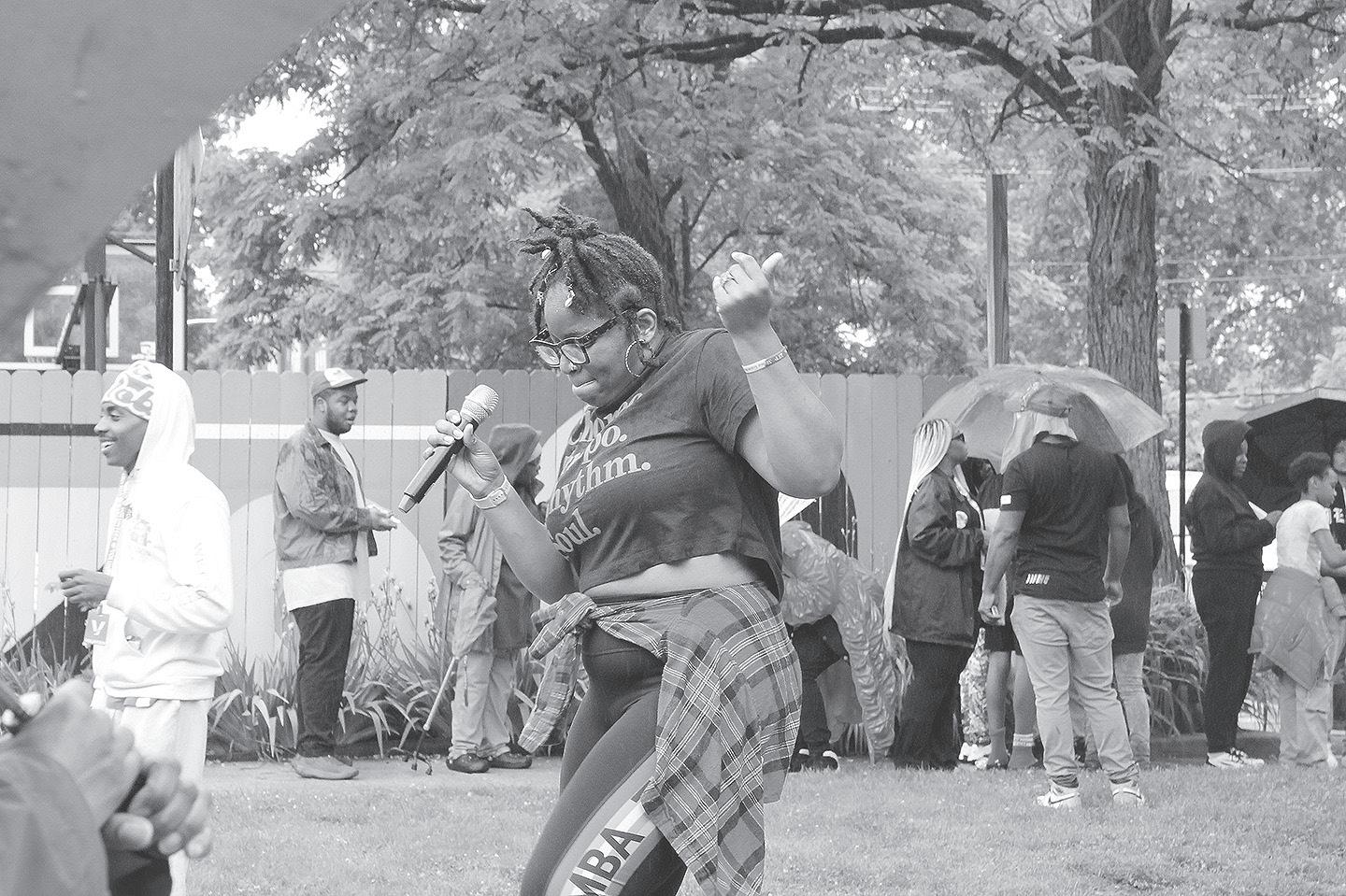
“We’re trying to reverse the stereotype about ‘Black-on-Black crime,’” said Michelle Rashad, Imagine Engleweood if’s (IEi) executive director. “We can’t ignore that it still has had great impact on our communities, on all of us, [but Peace Fest is about] being able to come together with those joys to heal some of the trauma that we’ve all experienced.”
IEi, a nonprofit that creates safe and empowering spaces for youth and their families in the Greater Englewood community, started hosting the festival about eight years ago as one of its signature annual events to honor gun violence victims and survivors and their families. This year, the block-party-style festival took place the weekend before Wear Orange Weekend, a national initiative to raise awareness about the impact of gun violence, which originated after the fatal shooting of Hadiya Pendleton on a Chicago playground in 2013.
IEi’s Peace Campus activated its community garden, nature play lot, basketball courts, and main Peace House to accommodate Saturday’s festivities.
The family-friendly activities, such as artmaking, were supplemented by a wide range of service providers and free food.
Alia Ramirez, the founder of Eenie Juice, was a vendor at this year’s Peace Fest, selling her all-natural juices. “I had a good turnout. I’m almost sold out actually!” Ramirez said. “I was kinda iffy about it because I’m like, ‘Dang, it is raining, but everybody came out and came through.’”
A large portion of Honore Street was blocked off, and a stage made space for DJs and other performers throughout the event. “We want to highlight the sonics of Black culture—the diaspora, if you will, of sounds from soul to hip-hop,” said Heavy Crownz, IEi’s Peace Campus director. “We gonna have folks out there line dancing to house music and footworking….You can never have enough times where we as Black people are loving on each other and sharing space.”
Crownz’s vision came to life with DJs playing house, Afrobeats, soul, hiphop, and more throughout the day. Local Zumba instructor Maya Robinson radiated
upbeat energy despite the gray skies as she led participants through various line dances. Several community organizations supported the event. Chicago Survivors, a crisis support services organization for families of homicide victims, regularly participates in Peace Fest to offer resources and support to the community.
Jasmine Rhones, Chicago Survivors’s community of survivors manager, attended Saturday’s festival. She and the rest of her team introduced participants to the organization’s emotional support dog and spoke with newer organizations about the community services they provide. “Without fail every year we have people come up and say, ‘[I] had a loved one that was killed, and I didn’t know about you guys,” said Pedro Gonzalez, Chicago Survivors’s family support manager. “When we do events like this, we are able to get people to know about us.”
These community losses and collective healing work are personal to IEi’s leaders, Rashad and Crownz, who are both West Englewood natives. Rashad recalls the loss of a childhood friend, Starkesia Reed, who was killed by a stray bullet while getting ready for school in her home. Rashad said joining IEi as a high schooler helped her feel reconnected to her neighborhood after the tragedy. “IEi really shifted or showed me that in community you’re able to process that, yes, this is wrong, and this is an effect of a much larger issue,” she said. “In community, I feel like those messages were able to give people more peace of mind and understanding and healing.”
Crownz also understands how easy it is to move into a state of desensitization and normalization around community violence. “I’ve lost more personal friends than I can count on my hands from Englewood since I was twelve or eleven,” he said.
For Rashad and Crownz, IEi’s
work at-large focuses on identifying the structural inequities, systemic racism, and lack of resource investment that often lead to violence. Peace Fest in particular serves to introduce people to resources they might be unfamiliar with while also creating a safe space for survivor families to feel cared for and connected to community.
Olympia Cure, a longtime Englewood resident, attended the fest to offer double dutch for other community members as a part of the 40+ Double Dutch Club. “I love the energy, the people, the smiles, the camaraderie—just being able to interact and socialize with some residents and community leaders,” Cure said.
With beloved block parties and festivals like the Silver Room Block Party and Hyde Park Summer Fest discontinuing this summer, the need for additional gatherings on the South Side to commune and celebrate feels essential. These spaces are in many ways an opportunity to cultivate a sense of joy and trust that builds resiliency in the face of violence and support on the collective path toward healing.
“It sometimes can be so overwhelming with the work that still needs to happen, the justice that still needs to be served, the wrongs that still need to be [made] right,” Rashad said. “We heal and grow in community, so it’s about us coming together to grow and heal and celebrate together.”
As tents and tables were folded and stored with the fest nearing its end, attendees continued to dance to the music with broad smiles on their faces, undeterred by the rain. ¬
Jasmine Barnes is a Chicago-based facilitator and multidisciplinary writer calling on the Black womanist tradition in her work. You can learn more about her by visiting her website: www.jasbarnes.com.
Celebrating Juneteenth at Marquette Park
More than fifty years after Martin Luther King, Jr. was attacked at Marquette Park, the scene looks much different and celebrates a growing annual Juneteenth event.BY MICHAEL LIPTROT
Growing up in Englewood, Ifatola Tifase didn’t know what Juneteenth was. She never saw the holiday celebrated in her community. Like many African American people, she didn’t feel connected to her enslaved ancestors or her roots in Africa. The extent of her knowledge was knowing that her family originated in the South, before moving to Chicago.
As an adult, Tifase set out to learn about herself and her roots. That journey led to her founding Tola's Creations Botanica Annual Juneteenth Celebration, which celebrated its fifth year on June 15. Tifase also owns Tola’s Creations Inc. at 2943 W. 71st St., a wellness center that hosts yoga workshops, sells spiritual supplies such as candles, incense, and herbs, and works towards the mission of “Bringing African Culture to You.”
“I simply wanted to celebrate our freedom,” Tifase told the Weekly. “We weren’t free on July 4 and that is a big holiday…Once I learned of Juneteenth, the meaning behind it, I wanted to celebrate the meaning of our people.”
This year’s celebration was hosted outside the field house at Marquette Park. The event focused on promoting mental health and wellness, featuring yoga sessions, a keynote address by Yoruban spiritual leader Adekunle Akangbei, and a variety of vendors including the City of Chicago Office of Emergency Management and Communications (OEMC), the Cook County Sheriff’s “Tails of Redemption” program, and wellness experts.
Juneteenth celebrates the end of chattel slavery in the former Confederate States. On June 19, 1865, Union troops led by Major General Gordan Grander enforced the Emancipation Proclamation in Galveston, Texas. The Proclamation was initially signed by Abraham Lincoln

on September 22, 1862 and took effect on January 1, 1863, legally freeing enslaved people in the Confederacy. Those enslaved in Union states were not freed until the 13th Amendment to the Constitution was ratified in December 1865.
Last September, Tifase took her family to Ashton Villa in Galveston, the site of Confederate headquarters in Texas where Gordon announced the Emancipation Proclamation. “I felt obligated to at least learn more about the holiday I so diligently celebrate every year and encourage other people to do so,” Tifase said. “It felt empowering.”
Nearly sixty years ago, Marquette Park may have seemed an unlikely place for an event celebrating the struggle for freedom. In 1966, Dr. Martin Luther King Jr. visited Marquette Park to galvanize supporters around housing justice. A mob of 700 white protesters met King as he exited his car. As he began to march towards a real estate office on 63rd Street, a rock struck King in the head. As he kneeled from the impact, others surrounded him to protect
him. By the time the march neared its destination, a riot broke out.
“I’ve been in many demonstrations all across the South, but I can say that I have never seen—even in Mississippi and Alabama—mobs as hostile and as hate-filled as I’ve seen here in Chicago,” King told reporters afterward, the Tribune reported in a 2016 story for the fiftieth anniversary of the confrontation. King’s Chicago movement included moving to North Lawndale, where he described the housing conditions as “wall-to-wall rats and roaches.”
Nowadays, the scene at Marquette Park is much different. Today stands the Martin Luther King Jr. Living Memorial at 6743 S. Kedzie Ave to mark fifty years since King’s march for housing justice, sponsored by the Inner City Muslim Action Network (IMAN) and commissioned by the Chicago Public Art Group. Three brick pillars depict King and community members who were with him that day from the Jewish Council on Urban Affairs, Operation PUSH, and other religious leaders. The word “home” is written in several languages on the memorial.
Marquette Park on June 15 was like many summer Chicago Saturdays. Predominantly white golfers teed off as mostly Black and Mexican basketball players shot hoops. Nestled behind the field house, which doubles as the Marquette Park Cultural Center, dozens of attendees perused vendors’ stalls and listened to the historical discourse.
“I think of [Juneteenth] as something that brings more people together. Like the 4th of July, but for Black people. I know that it’s a deeper meaning than that, but I think that’s the way a lot of people see it, including myself,” said Deja H., a resident of Bronzville. “If I’m being honest, we should know the history behind it. It’s still nice that it gathers the community. It’s a good start.”
Like Tifase, Hayes did not become fully aware of the holiday until later in life. Despite growing up in Texas, the Marquette Park event was her first time celebrating. She attended after seeing the event promoted online hoping to build her connection to Chicago’s Black community and become more active. “I figured, since I don’t know much, this would be a good time to learn,” she said.
Tifase said she ultimately hopes that her events encourage Black people to learn more about their connection to Africa.
“The branches of this tree are learning the importance of the roots, and so going back [to Africa], embracing that culture, learning our roots,” she said. “I’m the first in my family to branch out. They thought I was crazy, at first, to travel over there by myself and connect with my people, with family, re-engage with family. Now they understand the importance of what I do.” ¬
Michael Liptrot is a staff reporter at the Weekly and the Hyde Park Herald
Mayor Johnson Discusses His Organizing Roots and Vision for Chicago
Johnson highlighted his administration’s diversity and progressive legislation and pledged to remove ShotSpotter listening devices.
BY JIM DALEYIn a brief but wide-ranging interview with the Weekly last Friday, Mayor Brandon Johnson touted his firstyear progressive wins and said that previous administrations’ “intentional” disinvestment from marginalized communities is the biggest challenge he faces as mayor. He also said his organizing background has informed how he has staffed his administration and his approach to public safety and education.
“We’ve been able to organize a diverse administration, a diverse City Council, and progressive legislation that speaks to the people of Chicago who need our diverse leadership in order for their ideas and aspirations to actually be realized,” Johnson said.
The mayor also affirmed his commitment to ending the City’s relationship with ShotSpotter, and promised to ensure the company’s more than 2,500 gunshot-detection devices blanketing Chicago’s South and West Sides are removed on his watch.
Asked what strengths he brings to the Fifth Floor from his time as organizer, Johnson said the first thing that came to mind was assembling an administration that is racially diverse. He rattled off stats to back the claim: 43 percent of his administration are Black people, about 25 percent are Latinx, and roughly 29 percent are white, he said. In March, a Sun-Times analysis found similar demographics among his top officials: 45 percent Black, 25 percent Latinx, and 30 percent white. The mayor added that more than half of
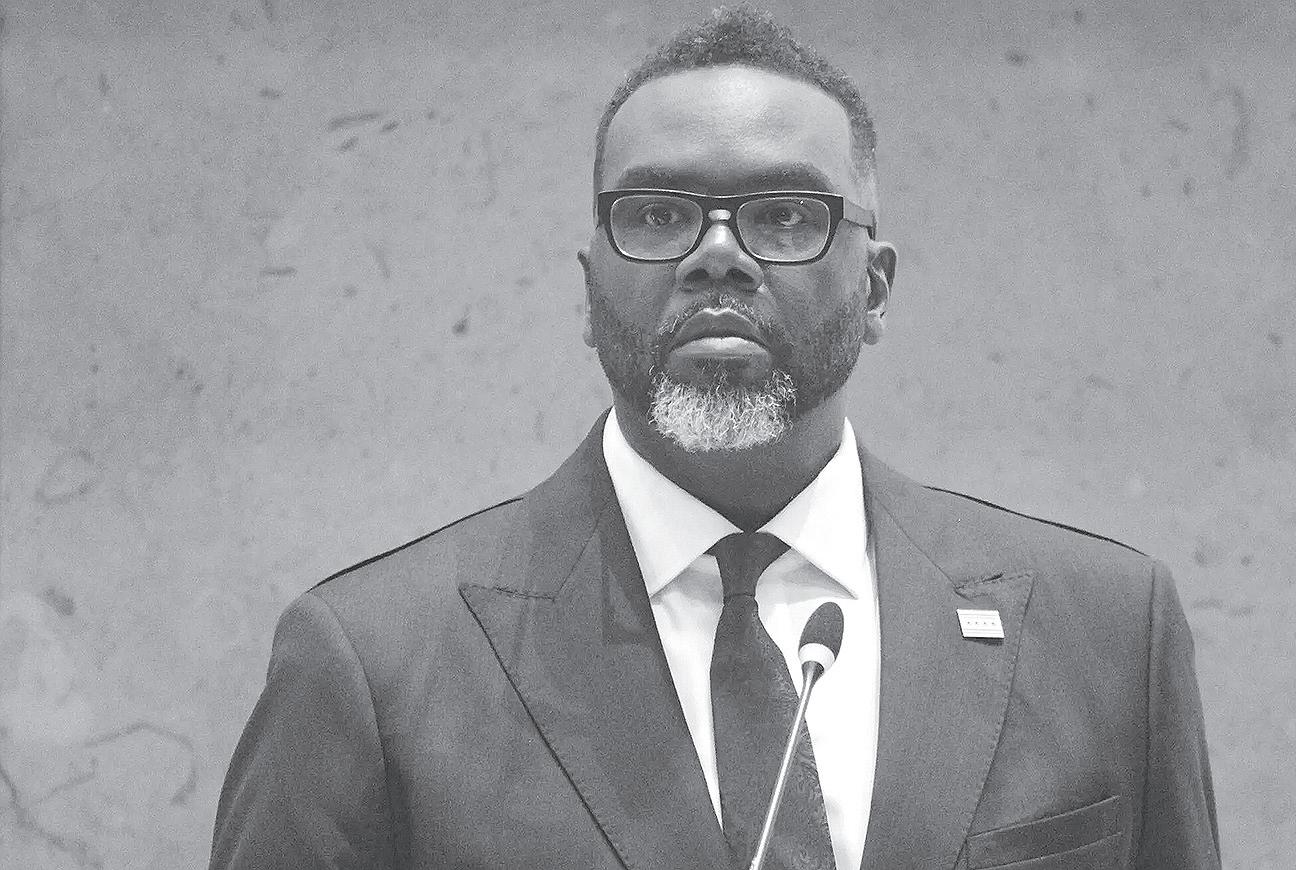
his administration is made up of women.
Johnson also pointed to his picks for City Council chairs, calling the group the “most diverse chairs that we’ve ever seen in the history of Chicago.” Nine of the Council’s twenty committees are chaired by Black alderpersons and six by Latinx alderpersons. Five are chaired by white alderpersons (one of whom, Debra Silverstein, is the body’s sole Jewish member).
The mayor said he’s been “effective” at moving progressive legislation through the Council, some of which was stalled under former Mayor Lori Lightfoot. He noted the passage of the One Fair Wage ordinance, which will gradually raise
tipped workers’ base pay over the next five years, and the Paid Leave and Paid Sick Leave ordinance, which mandates the accrual of paid time off. Both ordinances will take effect July 1.
He also touted his administration’s efforts around reopening mental health clinics and securing a five-year, $1.25 billion bond for economic development, as well as his push to convert office buildings in the Loop to residential units. The plan, which would create 1,000 apartments on LaSalle St., more than 300 of which will be “affordable,” meaning residents who earn 60 percent of the Chicago area’s median income (or $67,260 for a family of four) will be
eligible to rent them.
“Who in the history of Chicago would have ever imagined that you would have ‘downtown’ and ‘affordability’ in one sentence, right?” Johnson said. “In order for us to be better, stronger, and safer…we have to invest in them, and that’s exactly what I’m doing.”
The mayor noted his efforts to expand public mental health services, which include a recent announcement that the City will reopen a public mental health clinic in Roseland, one of fourteen that have been closed since 1989, and add mental health services at facilities in Pilsen and Garfield Park.
He also said the City’s youth summer jobs program is “in a position to hire up to 28,000 young people,” which would be an increase of about 4,000 youth jobs from 2023.
In response to a question about what challenges his time as an organizer may have not quite prepared him for, Johnson cast a stern eye on previous mayors, saying they had been running the city “into the ground” with “clear disinvestment” and systemic racism.
“It was intentional. Schools were closed. Public housing was shut down. Pensions were raided. You had the parking meters sold off. You had the Skyway sold off, right? So you had real intentional disinvestment from previous administrations,” he said. “And so, of course, the challenge is undoing forty years of systemic racism. That’s not something that you can turn around
overnight. We didn’t get it overnight. So those challenges are real. The gross neglect and the intentional disinvestment by previous administrations have left this city with the type of challenges that I’m embracing now.”
When the interview turned to education, the mayor did not directly answer a yes-or-no question about the possibility of closing public schools during his tenure. Instead, Johnson noted that he participated in the 2015 hunger strike that forced then-Mayor Rahm Emanuel to reopen Dyett High School on the South Side, and offered a quote from W.E.B. DuBois.
“The moratorium already exists,” he said. “I fought to make sure that it happened.”
A 2021 state law backed by the Chicago Teachers Union (CTU) that set in motion the creation of an elected Board of Education also placed a moratorium on school closures until 2025. In April, Margaret Croke, a Democrat whose district includes Lakeview and Lincoln Park, introduced a bill that would have extended the moratorium until 2027, when the board will be fully elected. After the bill passed the Illinois House, Johnson asked Senate President Don Harmon to hold the bill, and Harmon obliged.
“Public education for all at public expense was, in the South, a Negro idea,” DuBois wrote in 1935 in Black Reconstruction in America. Johnson said these words were “the most important thing to remember” during the discussion about his vision for education. “I said we’re going to invest in neighborhood schools,” he said, adding that he’s the first Chicago mayor to send their children to CPS schools and to have taught in CPS. “That is what we should be focusing in on, because that’s what I promised to do.”
Johnson said his vision for education is greater than the CTU contract or even the school district itself. “This is about someone who is the mayor of the city of Chicago, who is a descendant of slaves, whose greatest aspiration is to make sure that our public accommodations work for everyone,” he said. “Of course keeping schools open is a top priority, but it has to be more than [that]. It has to be about
investing in those schools, investing in those children, investing in those families, having sustainable community schools so that they work for everyone.”
He added that ensuring the City is creating “economic opportunities for good paying jobs” for families experiencing housing insecurity is also part of that vision. “This is not just simply about a moratorium” on school closures, he said. “This is about an overall vision for public accommodations.”
On Friday, CPS (which faces a looming $400 million deficit as COVID-19 funds dry up) and the CTU began holding the first public contract negotiations in history; the first round
including by casting a tie-breaking vote to pass a resolution calling for a ceasefire in Gaza—said that he’s been willingly arrested while protesting as a CTU organizer. Under his watch as mayor, the City’s handling of nonviolent protests by progressive activists has been inconsistent. Chicago police have issued citations to Jewish protesters who blocked traffic; refused to assist University of Chicago police in clearing a pro-Palestine student protest camp; and sent SWAT and tactical cops along with patrol officers to clear similar encampments at the Art Institute and DePaul University. The police cleared the DePaul encampment while Johnson was in Canada on a trade mission.
“It was intentional. Schools were closed. Public housing was shut down. Pensions were raided. You had the parking meters sold off. You had the Skyway sold off, right? So you had real intentional disinvestment from previous administrations. So, of course, the challenge is undoing forty years of systemic racism." — Mayor Brandon Johnson
of talks focused on climate solutions. Johnson bristled at a question about whether, given his previous role in the union, the public could trust that the outcome of the negotiations hasn’t been predetermined.
“I think you have to read past some of the headlines that even you might be responsible for creating,” he said. “If you believe that I come from the CTU after I just told you that I’m a descendant of a slave, you’re missing what I’m saying, and I don’t mean any disrespect. What I’m saying is that the harm that has been caused by previous administrations is quite severe.… I have a responsibility to make sure that I show up for the people who need me to show up for them. And I’m talking about people who have been placed at the margins.”
Johnson, who has repeatedly affirmed his support for progressive causes—
especially because, again, my existence is because people protested in this country.”
In January, Johnson announced he would cancel the City’s contract with ShotSpotter, a controversial gunshotdetection technology company, in September. Since then, alderpersons have pushed back on the decision, passing legislation that they say gives the City Council final say on the contract. Johnson has said the legislation is dead on arrival because the City’s procurement process leaves the decision solely with the mayor.
Last month, a Weekly investigation revealed that ShotSpotter not only doesn’t always remove its gunshot sensors when contracts expire, but in some cases continues listening and collecting data, which it has made available to police departments in cities where contracts lapsed. The City’s contract with ShotSpotter requires the company to “make every effort to assure an orderly transition to another provider of the services, if any, orderly demobilization of its own operations in connection with the services.”
Johnson pledged to ensure the ShotSpotter sensors are removed under his watch. “I'm gonna remove them,” he said. “I’ve made it very clear that, as you know, ShotSpotter has proven to be ineffective, and so we will remove those devices.”
Protests are expected to ramp up in August, when the Democratic National Convention descends on Chicago. Block Club reported earlier this month that CPD superintendent Larry Snelling, a Johnson appointee, said that protesters’ right to assemble under the First “is only there if you’re not committing a crime, and you can be acting out peacefully but still breaking the law.”
Asked whether he agrees with the superintendent, Johnson said, “Constitutional policing is the standard, period, point blank. And protecting First Amendment rights, that’s fundamental to our democracy, and that’s what I expect from my police superintendent and that’s what he is delivering. Ensuring that people have safe and peaceful protests, that’s the most important element here: safe and peaceful. And I believe in the fundamental right to be able to protest,
Earlier this month, Johnson made two appearances at House Fest in Millennium Park, where in the afternoon some in the crowd booed the mayor while others stopped to take selfies with him, all smiles. The Weekly attempted to pin Johnson down on a matter of taste: of Chicago’s mainstay subgenres, does he prefer Deep House or Juke?
Johnson demurred. “It’s because my kids might read this one day,” he explained. “So how about just say this: I bob my head a lot. Because if I admit to juking...I got a daughter, and she’s gonna make fun of me. You know, ‘Daddy can’t juke,’ or whatever. But deep down, I think that everyone has a juke inside of them, don’t they?” ¬
Jim Daley is the Weekly’s investigations editor.













Bearing the Cost
State politicians seem unwilling to support the Bears' proposal for a new stadium. Is the investment worth it?BY MALACHI HAYES
It’s been an offseason of uncertainty for the Chicago Bears.
A year after a long-anticipated deal to move to Arlington Heights fell through over a property tax dispute, the team returned this spring with an ambitious proposal for a new stadium on Chicago’s lakefront.
The would-be state-of-the-art domed facility, that couldn’t bear less resemblance to the team’s current home at Soldier Field, received plenty of fanfare. After being conspicuously left out of the state budget for the coming year, though, they’re once again back at square one.
Released with flashy visual mockups and the strong backing of Mayor Brandon Johnson, the team touted the project’s majority-private funding, calling it “the largest private investment in Chicago’s history.” Nonetheless, the Bears requested more than $2 billion in state subsidies for construction and surrounding infrastructure. Now, with the legislature declining to include said subsidies in last month’s budget proposal, the idea may be dead in the water, at least for the time being.
Robert Peters (D-13), who represents the proposed stadium site in the Illinois Senate, was absent from the coalition of elected officials who endorsed the project upon its release.
“I don’t think there’s necessarily an appetite to just give billionaires a whole bunch of money,” Peters told reporters last month. “They need to be realistic in what they ask for.”
In their proposal, the Bears claim the
project will generate 24,000 temporary jobs for Chicagoans and 2,300 permanent jobs thereafter as well as “1.3 billion in fiscal revenue” over the next thirty years.
The team also projects an annual gross income of $92 million on those jobs. That works out to an average income of $40,000 that Miles MacClure, writing in the Reader, noted falls well below the city’s rising housing costs.
The Bears estimate that the city, county, and state can expect an
positions across various fields like hospitality, accounting, legal landscaping and security to name a few,” a Bears spokesperson said via email.
In addition to jobs, the facility would offer “opportunities for young people to take full advantage of open space and better access to the top tourist destination in the entire state of Illinois,” wrote Ronnie Reese, Johnson’s communications director, in an email to the Weekly. Other members of the state
The hotel tax has spent the last four decades quietly skimming off the top of Chicago’s diverse travel and tourism industries.
Virtually none of that revenue has trickled down to Chicagoans, though.
“additional” $64 million in annual tax revenue, according to the Tribune. The team says that’s a 37 percent increase over current levels, though it still falls short of the more than $2 billion in public subsidies they’re requesting. They did not initially present further details on the nature of those jobs, or those projected revenue increases.
“Although we don't have a precise breakdown of the jobs by industry, the development will generate well-paying
legislature voiced concern over the team’s request for expedited approval from the state. “I think a proposal of this magnitude deserves sunlight and scrutiny,” State Rep. Kam Buckner (D-26) told the Tribune “Very often, what has happened in [state government] is that things get rammed through at the last minute without much input and transparency.”
Even with Johnson’s ardent support, there is no viable path for the Bears to get public subsidies without the backing
of state government. The majority of the proposed public funding originates from the Illinois Sports Facilities Hotel Tax, which is administered by the Illinois Sports Facilities Authority (ISFA), a state agency created in 1987 that’s responsible for financing and maintaining publiclyowned stadiums. Any large projects undertaken by the ISFA will need to be reflected in the state budget.
Governor J.B. Pritzker, one of the nation’s staunchest critics of awarding public subsidies to professional teams, called the Bears’ proposal a “nonstarter” last month, indicating the issue is “not a high priority” for the state.
“We’ve seen other teams be able to support their own stadiums privately. That’s [what] would be ideal here,” Pritzker said in February. A spokesperson for the governor declined to offer further comment on the issue.
In his support of the Bears’ plan, Johnson has repeatedly emphasized that the proposed funding draws from an already-existing tax. “I’m going to repeat that one more time to make sure everybody gets that,” he said at an April 26 press conference about the stadium proposal. “This project will result in no new taxes on the residents of Chicago.”
With the “year-round” attractions the domed 77,000-seat proposed facility would accommodate, he later added at the same press conference, “Chicago will generate significant new revenue that will support my commitment to investing in people.” But Illinois lawmakers still need to be persuaded that the Bears’ plan is a wise use of that tax revenue, whether it’s
new or not.
That’s because the ISFA, a state entity, is responsible for managing the debt undertaken to pay for early2000s renovations to Soldier Field and Guaranteed Rate Field. Three of the ISFA’s six board seats are appointed by Johnson, with the remaining three appointed by Pritzker. The director is appointed by the mayor with the governor’s approval.
The ISFA receives annual subsidies from the city and state, but most of its revenue is sourced from that two-percent city hotel tax. The idea that tax money from visitors and tourists’ pockets, rather than Chicagoans, will pay for the project has been another point of emphasis for the deal’s proponents. Whether that’s necessarily a good thing is another matter entirely.
The hotel tax has spent the last four decades quietly skimming off the top of Chicago’s diverse travel and tourism industries. Virtually none of that revenue
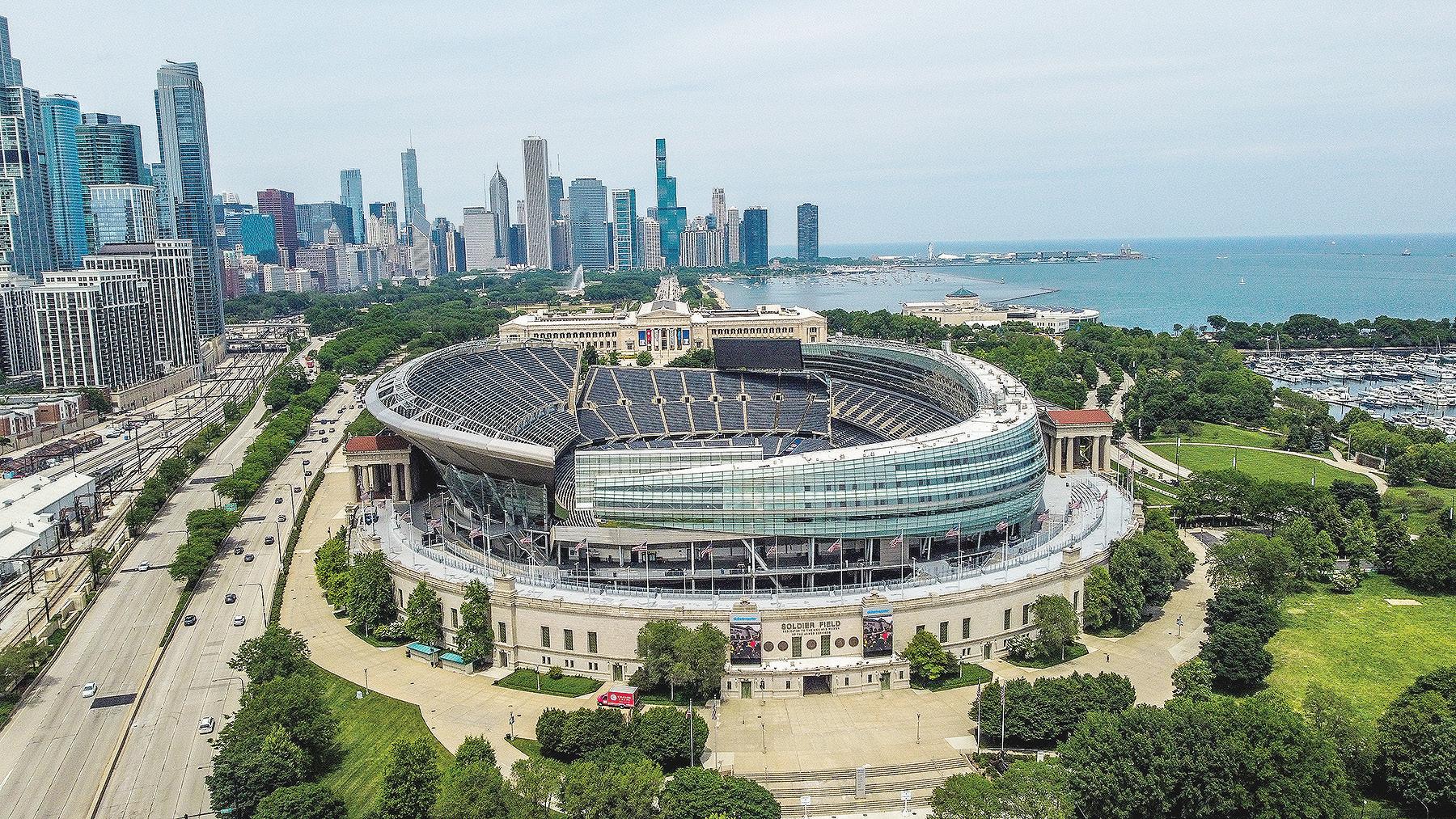










has trickled down to Chicagoans, though. Since 1989, the ISFA reported more than $1 billion in gross hotel tax revenue, with more than $600 million since 2009 alone, according to data received in response to a public records request. According to the ISFA’s annual reports, nearly all of it has gone toward interest payments on the enormous debt undertaken for Soldier Field and Guaranteed Rate Field. Nonetheless, the ISFA reported a budget shortfall for three consecutive fiscal years between 20202023, with COVID-19-related damage to hotel revenues preventing them from fulfilling debt obligations to the state. Those financial woes are unlikely to die down anytime soon. That may be one reason state lawmakers are hesitant to sign off on any new arena plans. The ISFA has struggled with the debt’s heavily backloaded payment schedules, restructuring it with new bonds in 2014 and 2021. As a result, despite the projects now being decades in the rearview mirror,

more than $500 million is still owed on them and isn’t due to be fulfilled until 2032.
Karen Murphy, now the Bears’ chief operating officer and executive vice president of stadium development, told the Sun-Times the team’s proposal includes yet another refinancing of those debt obligations. It’s a plan supported by city chief financial officer Jill Jaworski, who explained her position to the SunTimes by stating the debt’s ballooning payment schedule late in the decade would likely pose problems for city finances if not reworked. The Bears’ plan would see the existing debt wrapped into an additional $1.2 billion in new ISFA bonds to be repaid over forty years with hotel tax revenue. This essentially maintains the status quo into the 2060s.
It may not be a new tax, but a commitment to forgoing four decades worth of substantial income is no small ask. Besides, Chicagoans might be forgiven for being wary of such longterm contracts. Recent sales of highprofile public assets like the Chicago Skyway and municipal parking meters, for example, backfired in almost no time, as it soon became clear that the revenue surrendered by the city would dramatically exceed what it had been paid up front. It’s easy to see why lawmakers might question the wisdom of what amounts to taking out a forty-year loan to address the ISFA’s already-spiraling debt load.
The Bears’ lease on Soldier field runs through the 2033 season, though they have an option to terminate it early at the cost of $84 million. The ISFA has no stated plans for hotel tax proceeds beyond fulfilling the current debt (though the Tribune reports that the money is legally set to be directed to McCormick Place after stadium repayment is complete). The real price to Chicagoans, then, may not be in money taxed out of their pockets, but in the opportunity cost of forgoing other uses for the tax for decades into the future.
Revenue for Soldier Field in its current form is projected to be just over $50 million in 2024. Though it accounts for just less than a tenth of the Park
District’s overall take, it’s still their second-biggest revenue generator. No party involved has said how a potential loss or reduction of that revenue—which includes the Bears’ $7 million annual rent payment and related parking proceeds on Soldier Field—may impact Park District services moving forward.
The Bears’ presentation noted that the “economic impacts” of recent Super Bowls have been estimated at between $350 and $400 million. Neither the team nor the city, however, has stated how much extra revenue they project from hosting events that Soldier Field is currently unable to facilitate. When reached for clarification, the Bears reiterated the reported economic impacts of the last half-decade’s worth of Super Bowls and Final Four weekends, neither of which have been hosted in Chicago. Having asked for such a hefty commitment, the lack of concrete details has left fans and experts as skeptical as lawmakers. Stefan Mozer, who will be entering his forty-fifth year as a Bears season ticket holder this fall, doesn’t see the project as a local game-changer.
“I don’t think improving Soldier Field or building a new stadium will do much for the neighborhood. The neighborhood has already been mostly revitalized,” he told the Weekly. “There’s just not a lot of economic impact [in] that way.”
Decades of academic research back up Mozer’s sentiment that the purported community and city-wide impact is unlikely to materialize. In April, Johnson told reporters “Chicago will experience increased tax revenue from this investment…[with] stronger economic growth [for] generations to come.” Experts have their doubts. Noted sports economist Allen Sanderson told the Reader, “Whether it is an investment depends: Does it have a positive rate of return? And again, the answer is just overwhelmingly no.”
In March, stadium tax expert Geoffrey Propheter told the Weekly that “decades of research” show virtually no “tangible benefit” to similar kinds of funding deals. Whatever the size of the promised economic impact, it typically
falls short. Propheter projects the property tax breaks the Bears will get on their proposed stadium to be worth nearly $700 million over the course of the forty-year term.
Asked to respond to experts who’ve expressed doubts about the plan, a spokesperson for the Bears cited Chicago’s lack of inclusion in a Sports Business Journal article titled “The 25 Best Sports Business Cities” in the country, stating, “This stadium and recreational space proposal finally gives the city and state a world-class enclosed stadium that could host major events from concerts to sporting events, like the Super Bowl, to CPS graduations.”
Publicly, the Johnson administration has touted the transformation of the lakefront into green space with parkland, sports fields, and recreational areas based around Soldier Field. Johnson’s support for more publicly accessible parkland is well-taken, but some have questioned whether a redeveloped lakefront is a worthwhile priority for achieving that policy goal.
“It’s something of a bizarre baitand-switch approach,” said Fred Bates, a board member for Friends of the Parks, an environmental advocacy group, on behalf of the organization. “All [they’re] proposing,” he continued, “is to tear it down, put in some fields, and build another big stadium on the lakefront. And I think they’re pretending like that’s some kind of meaningful addition, which it isn’t.”
Bates doesn’t share Johnson’s hope that the proposed new parkland will be a difference-maker for Chicago.
“There isn’t a need for more playing fields on the lakefront. What there is a meaningful need for—and the Bears could fund this meaningfully in a heartbeat—is for more playing fields in the parks that are playing-fields-short,” said Bates.
“To pretend like creating hard-toreach playing fields is somehow going to help the communities in the city is pretty brazen, I would say.”
In any case, the legislature has spoken by way of their budget plans. If
we hear about this again, it likely won’t be until next year. The Bears’ focus remains on the lakefront, but the property they still own in Arlington Heights looms in the background as a potentially attractive plan B.
Perhaps the biggest obstacle of all for the Bears’ plans is that for all the hubbub, much of their fan base remains indifferent about keeping them in the city. A poll commissioned by former governor Pat Quinn found that 65 percent of those surveyed opposed subsidies for a new stadium, with just 25 percent in support.
Mozer, the longtime season ticket holder, thinks that Soldier Field is “adequate” and would have few issues if the Bears continued to play there. Still, although he’d strongly prefer to not have to purchase new, almost certainly more expensive season tickets, he wouldn’t be against an Arlington Heights move.
“I like Arlington Heights from a selfish perspective, as it’s much closer to where I live,” Mozer told the Weekly. “Parking is terrible [at Soldier Field], and expensive in the South Loop, and that seems unlikely to change with a new stadium.”
Bridgeport resident Conor Evans, twenty-eight, echoed Mozer’s sentiments. He called getting in and out of the Soldier Field area a “nightmare” and said even though he attends several games a year, “personally it wouldn’t bother me much.”
In a perfect world, the Bears would continue to call Chicago home, generating much-needed tax revenue for its residents while also giving them something to be proud of on the field. Reality, though, is usually more complicated. Sometimes, a parting of ways can be best for everyone involved. As hard as that may be. ¬
Malachi Hayes is a Bridgeport-based writer and South Side native.
The Show Must Go On
Chief Keef performs in Chicagoland for the first time in twelve years despite severe weather.
BY JORDAN ESPARZA-KELLEYThousands gathered this year for the Lyrical Lemonade Summer Smash Festival at SeatGeek Stadium in Bridgeview, just outside of Chicago. Every year this festival brings to town some of the hottest talent in hip-hop. But this year was special for the hometown crowd as the legendary, mythical Chicago artist Chief Keef was slated to headline the final night of the festival.
Chief Keef has essentially been living in exile from his hometown for the past twelve years, due to a mixture of legal issues and a general fear that his presence may result in violence. Keef’s attempt to perform via hologram in 2015 would be canceled when then-mayor Rahm Emanuel’s office released a statement stating that his music “promotes violence” and his performance posed a “significant public safety risk.”
As a pioneer of drill music, Chief Keef broke into the Chicago scene back in 2011 with his grungy yet realistic music videos and provocative lyrics, visually bringing us into his world and explaining the violence he was living through. He was a teenager who brought street life to the masses, as Keef and his friends fought to survive around poverty, violence, and their high school’s pending closure.
Sunday started out as a normal sunny, hot Chicagoland day. With everyone’s mind on one person: “Sosa,” aka Chief Keef. From the start of the day a severe weather warning loomed but didn’t seem likely.

It wasn’t until an absolutely chilling gust of wind swept through the area and the first drops of rain fell when people started
to exit. When myself and friends evacuated the festival we ended up in a food plaza parking lot where we spotted DJ Kenn,
the host of Chief Keef’s first ever mixtape “Bang.” For me, this confirmed that Chief Keef was not only performing, but was on festival grounds.
As the clock struck nine almost the entirety of the festival had converged onto the lyrical lemonade area to witness history, but Chief Keef was running late. He was scheduled for 9 pm and the show had a hard 10 pm curfew. 9:10 passed, 9:20, 9:30…and shortly after, he emerged from behind the stage, saying “Sosa back in the ‘Raq” as he put on a show for his hometown crowd.
The moment was phenomenal. The man, the myth, the legend, the pioneer, in an all-white silk button up shirt, and all his “mothafuckin’ jewelry on,” blessed Chicago with an approximate forty minute set, containing classics such as “Faneto,” “Earned It,” “John Madden,” as well as songs from his newest sixteen track album which dropped in May of this year. He ended with one of his biggest hits, the timeless, “Love Sosa.”
Chief Keef was also accompanied by his daughter Kay Kay, his Glo Gang affiliates such as Ballout and Tadoe. And later being joined by another hometown hero G Herbo to perform his classic “Kill Shit” and “Who Run It (Remix).” People climbed portable toilets for a better view, and screamed every word from the heart for the hometown hero.
Around 5:15 pm, dark gray clouds began to engulf SeatGeek Stadium, followed by a written and verbal message to festival attendees urging event goers to evacuate due to severe weather threats. But the crowd was not having it. Almost nobody moved towards the exits and the crowd quickly began to hurl items such as toilet paper and water bottles at the stage.
“Nothing was going to stop Chief Keef, much like his tumultuous upbringing, Keef was determined to persevere on a day that was reminiscent of his entire story.”
As fate would have it, nothing was going to stop Chief Keef. Much like in his tumultuous upbringing, Keef was determined to persevere on a day that was reminiscent of his entire story. After twelve long years, Chief Keef performed in Chicagoland and got to witness the love his people have for him in person. ¬
Jordan Esparza-Kelley is a photojournalist covering the arts, culture and social movements in Chicago. This is his first article for the Weekly

Chief Keef's Homecoming, Cactus Jack Reunion, and Stellar Performances at Summer Smash
The Bridgeview hip-hop festival navigated stormy weather for an unforgettable event.
BY JOCELYN MARTINEZ-ROSALES, PHOTOS BY ZELTZIN VAZQUEZLyrical Lemonade’s Summer Smash festival returned for its sixth year last weekend, once again lighting up SeatGeek Stadium in Bridgeview. The hip-hop festival attracted thousands of fans, all eager to witness a stellar lineup that proudly showcased some of Chicago’s finest talent. Undoubtedly, the highlight was the much-anticipated homecoming of South Side’s very own drill king, Chief Keef.
The three-day festival is put together by Lyrical Lemonade and production company SPKRBX featuring three dynamic stages and a lineup filled with more than fifty live performances. Windy City artists like Famous Dex, VonOff1700, Lucki, Freddy Got Magic (also known as Supa Bwe), and Mick Jenkins brought local flair to the scene.
The first night’s headliner, the Cactus Jack Records crew, reunited Travis Scott,
Sheck Wes, Don Toliver, and Sofaygo for their first performance since the 2019 album, JACKBOYS. Their set was delayed around forty minutes.
The festival wasn’t without its challenges. On Sunday around 5pm, the festival was evacuated as severe weather rolled in. Fortunately, the gates reopened an hour later.
Chief Keef took the stage thirty minutes late, but made up for it with a
high-energy nostalgic set, featuring a special Father’s Day appearance by his teenage daughter and a guest performance by beloved Chicago rapper G Herbo. Other big names to grace the festival stages included Kodak Black, Flo Milli, Big Sean, Lil Yachty and Lil Skies, ensuring a historic day in Chicago music for all.
Photos by Chicago music photographer Zeltzin Vazquez: ¬
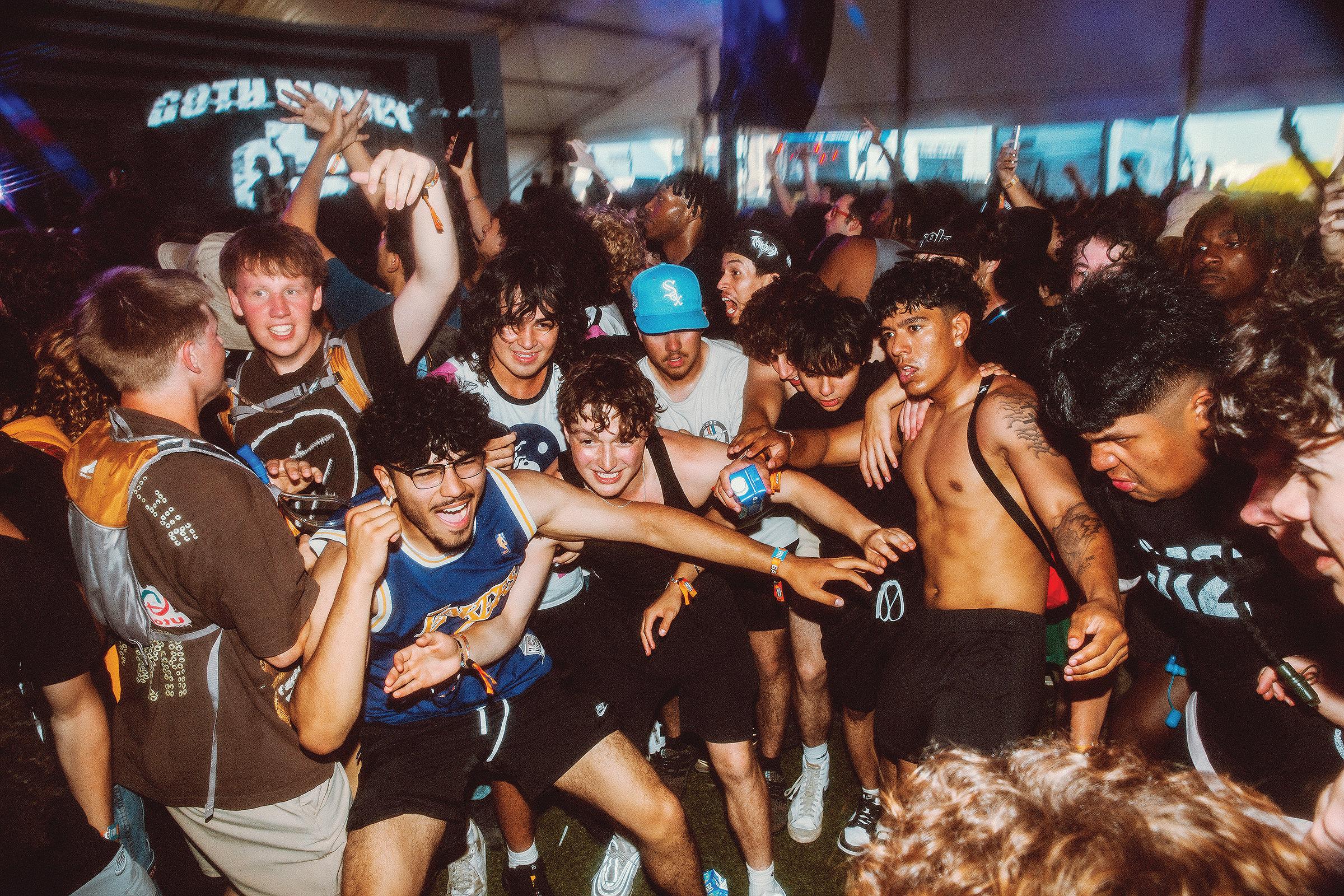

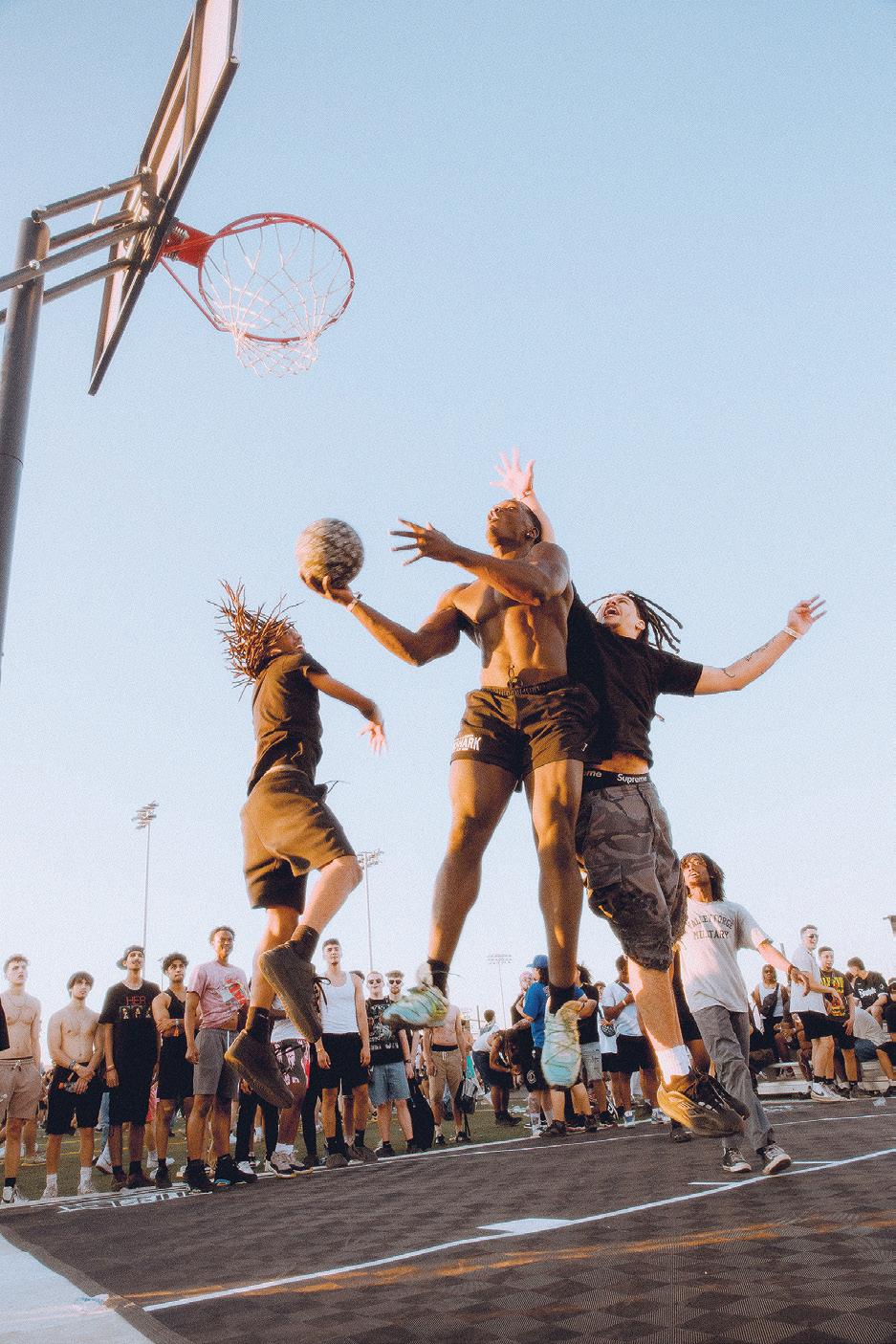
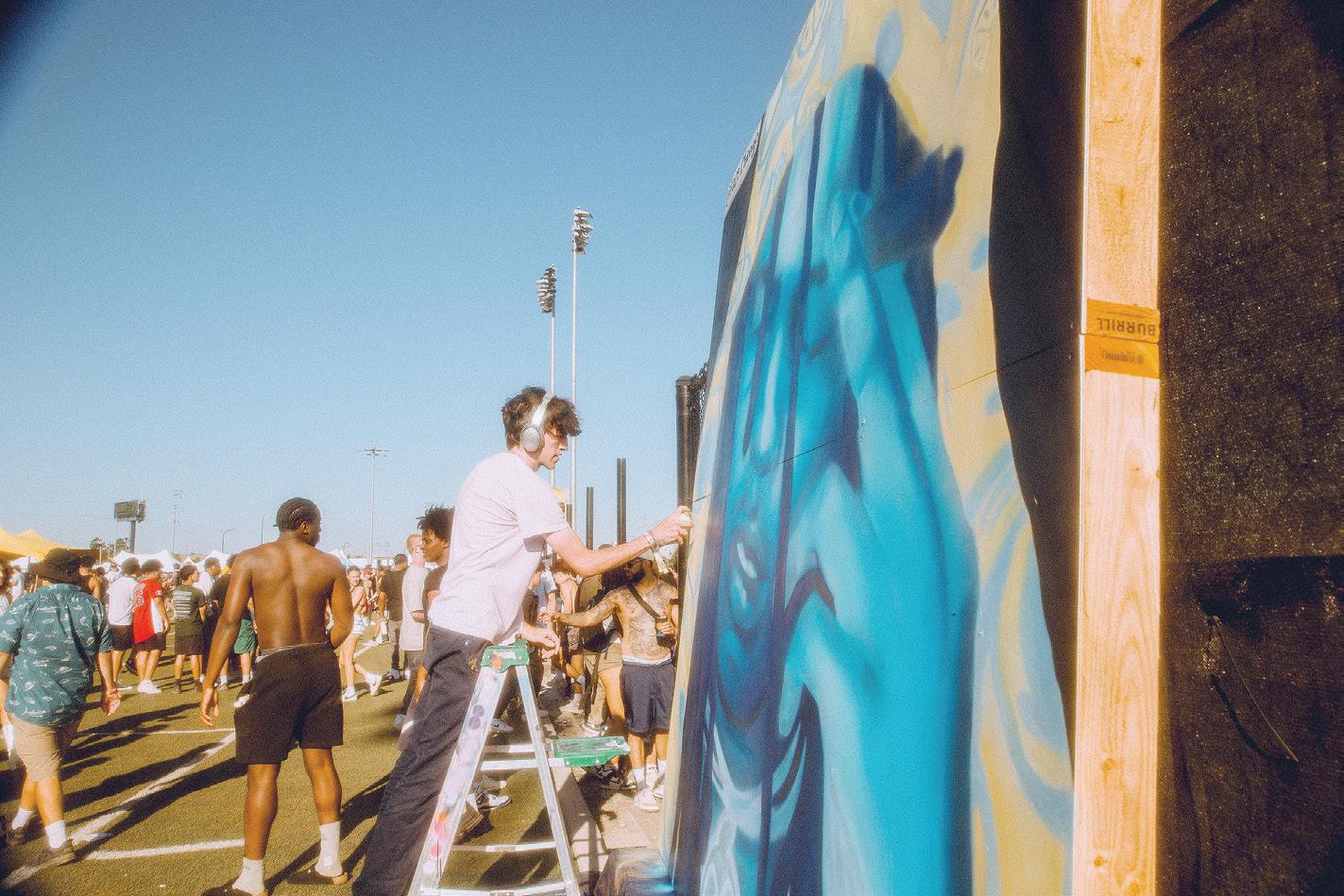
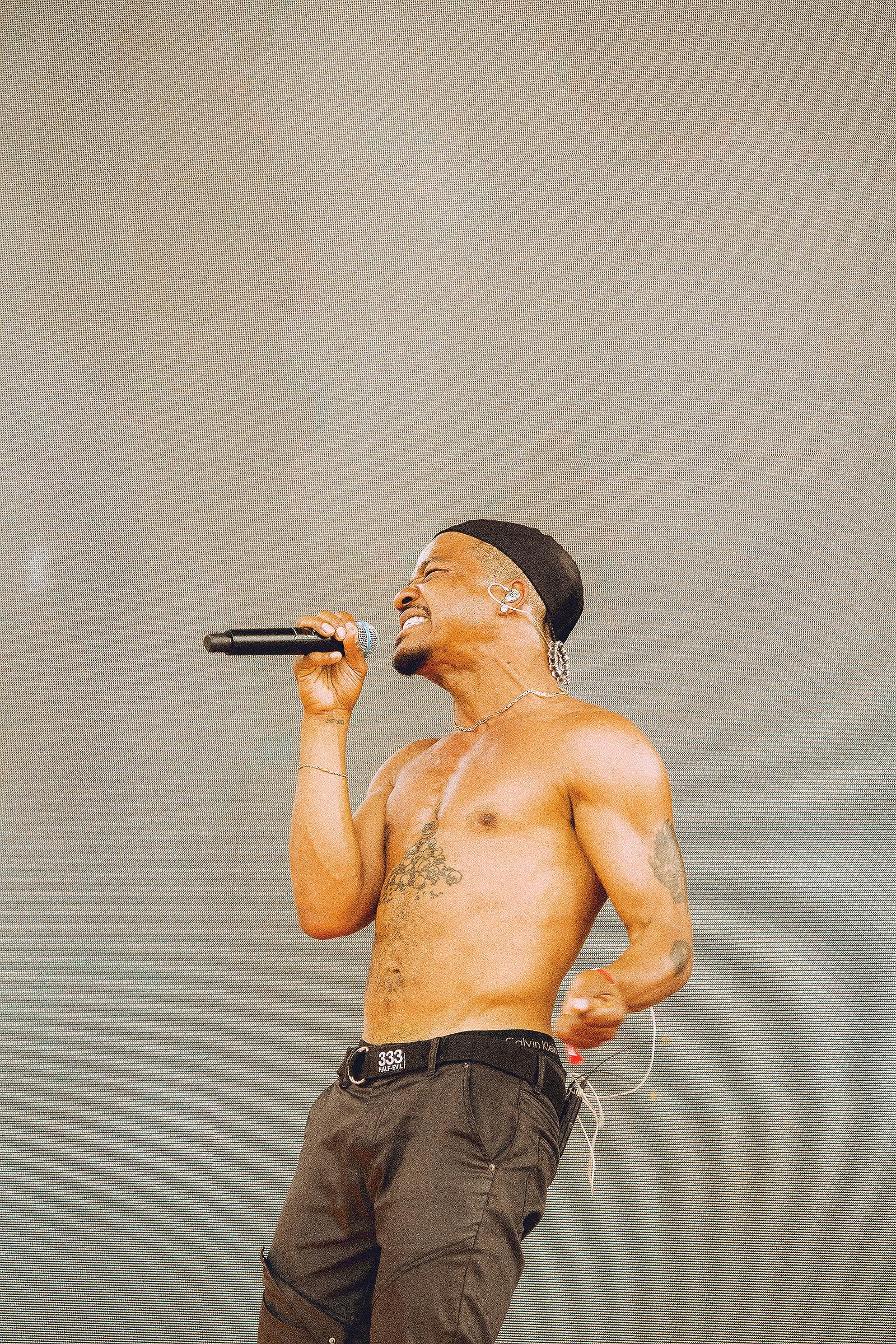

Consolidating Memories with
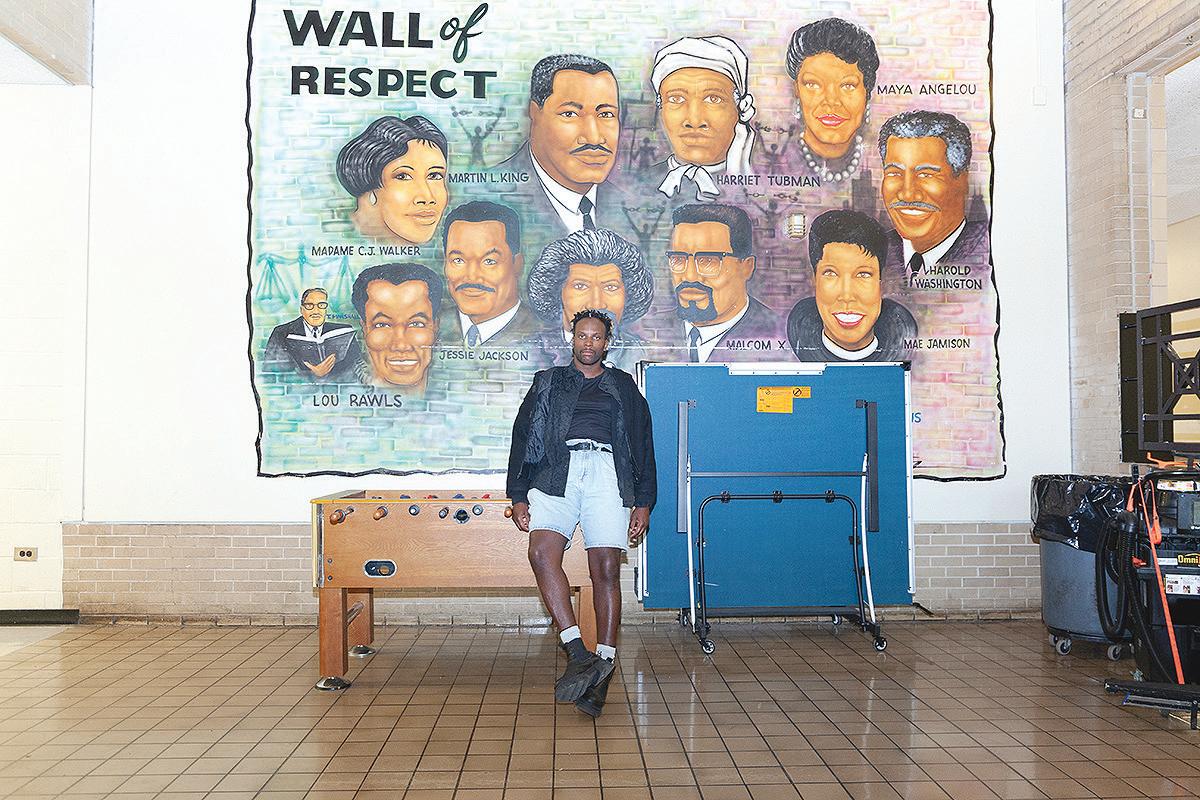
in Kendall’s photography that prompts assortment. Blur, double exposure, lens flares, and film grain create moments (or the illusion of moments) that demand explanation. There’s a mystery to his
Piggybacking off of our conversation in Swig, can you explain where you’re from and some of your early inclinations
didn’t consider it art, but it was, obviously. I did a lot of poetry competitions, and oratory, spoken-word stuff at church. And I really gravitated towards doing things like that. I wrote a bunch of young author typography and the words are winding and take on different shapes. It feels very childlike, but it’s obviously an intentional stylistic choice. So just talk about your use of words.
At this point in my writing journey I’m really trying to make people feel things without always having to read them. Which is kind of weird. It’s like you would think that as a writer, you just want to be more intentionally to the point. But I think because I’ve been doing so much visual art the last, you know, decade almost, I try to think about how to say things with words that are visually telling, rather than just specifically telling. I’ve written so many things like, I feel like I’ve gone through genres and different types of writing styles, and none of them were bad at all. I just can see my youth in them a lot. I think about stuff I wrote in college, and it was so detailed, and over the top, right, like really expressionism. And I’ve just gotten to a point where I’m kind of, like, how do I say things to make even the way that you’re putting words together make something new in someone’s mind? You know, there’s so many combinations of words that you can use, and oftentimes I’m just trying to combine them or lay them out on a page differently, to feel differently to whoever’s [reading] it. And photo helps a lot with that too. You know, the photography behind them also helps a lot, but yeah, really just trying to use words as another asset to make images.
What is FEVERDREAMS about?
This book is about the here and the now and putting a stamp on this time and place in my life. But it’s also about how dreams and ideas can become a reality. In a metaphorical and literal sense. Every photograph and chapter in the book comes from thinking bigger than what was right in front of me. It’s a place for us to not forget these moments of youth, or the brightness that comes from those times.
Talk about memory. Talk about dreams. And talk about how these memories comprise the dreamscape you’ve created in this book.
I think that those two concepts, memory especially, are just really obvious first thoughts when it comes to photography in my mind. Photography is able to hold memory, of course, right? And writing is able to also hold memory. But neither

of them are necessarily always true. And like, that’s really where this idea came from. Because it’s my first book, so I really wanted to capture all of these ideas and memories I’ve had and moments that I had over these last, really, ten years [of] shooting photos. But like, it wouldn’t hit as effectively to just tell the truthful story of what was going on in all these pictures. To
me. Or like, what does the collection of all these pictures around this similar theme of water [mean]? Like, how does that really interact with my mind. So I think that the creativity of the dreams and the memory really just allowed me a space to play with those ideas.
You mentioned friendship, and that’s
“Photography and writing are able to hold memory, right? But neither of them are necessarily always true.”
me, it made more sense to make a very real metaphor, like a very real thing that people can connect to, but it’s so out there that you can only really think about what is the metaphor of this. Even I don’t know the metaphor of these pictures. There’s so many people who are featuring the book right? Some of them I talk to still. Some of them are best friends. Some of them I haven’t talked to since these pictures. There’s all of these memories still wrapped up in me, trying to decode what they mean to me on a very personal level. And writing about it in this creative-dreamscape-memory way is the closest thing to like, trying to understand those things in my mind too, and like, best figure out what it means to
wanting to interact with your dreams by yourself. Or just getting to this point of self confidence through knowing who you are. You can know who you are through your experiences, [and] your experiences most of the time do have your friends [and] your family involved in them. So using friends is a way to understand something through all these crazy experiences and metaphors.
Having grown up on the South Side but moved to other places in the city, what would you say you still carry with you?
It’s weird but I still have this hunger to wake up everyday and make my moments and opportunities worth it. It’s actually embarrassing how early I wake up and get busy sometimes. I lived South Side local until I was twenty-two, but my life really started to shift to the north when I was in high school. Most days and weekends I traveled at least an hour, most times by bus or train, to go learn or hang out with the people I wanted to. My parents let me use the car on weekends but they never drove me anywhere. It felt like even then, I made myself really work to get to this idea of “worthwhile” in my mind. Which is totally still who I am now it feels.
What does it mean to be a Black male exploring this work and these forms? Do you feel like you’re pushing certain boundaries?
very well-represented in the book. All of these stories are about the main character’s interactions with other people, but there are moments of selfreflection in the book too. Do you see a central theme in this book being about learning yourself through other people and then reaching a point of clarity on the self?
Absolutely. That’s really what it’s getting at. It’s like learning yourself through other people, which I think we all do, you know without knowing it or not. And then like, reaching this point of Nirvana, of like, talking to yourself in a dream. And then being able to be alone on a beach and
For the past few years I’ve been focusing on this idea that my work, and the art of all Black creators and curators, contributes to this collective history we are all writing for the future to look back on and be inspired from. My individual actions don’t matter unless someone else is inspired enough by them to create their next idea—and sometimes, the one who needs inspiring the most is me. Some days I feel like I’m pushing boundaries. Most days I feel like I’m trying to discover my most authentic self, and figuring out how being more of me can help others be more of themselves.
FEVERDREAMS (DOLLHOUSE, 2023), is available for presale at www. kendall-hill.com/shop. ¬
Malik Jackson is the interim executive
Dying on Dart’s Watch
2023 was the deadliest year in the Cook County Jail on record, with eighteen deaths, many of them from drug overdoses. An Injustice Watch investigation found lapses in supervision and medical care were at play in at least half the deaths.
BY CARLOS BALLESTEROS, INJUSTICE WATCHThis story was produced by Injustice Watch, a nonprofit newsroom in Chicago that investigates issues of equity and justice in the Cook County court system. Sign up here to get their weekly newsletter.
Content warning: This story contains descriptions of people dying by suicide, homicide, and drug overdose.
The day before he died, Daniel Colon appeared in bond court via Zoom from a holding cell at 26th and California. The hearing was only a formality—his fate had already been decided—but as the judge was about to send him off, Colon spoke out of turn.
“Hold on, hold on, hold on,” he said.
“So the warrant from four years ago, I have to stay here for? Can you explain that?”
Colon ended up in bond court last February after Chicago police arrested him on the exit ramp off the Dan Ryan Expressway in Englewood where he often asked for spare change. The five officers who surrounded him that day said they were taking him in because of a warrant for missing court in 2018 for possessing five grams of heroin.
When Colon asked the cops why now, he got only cryptic answers. “Something has to be done now, all right? Nobody wanted this to happen,” the arresting officer told him, according to audio footage from the officers’ body-worn cameras.
The warning signs were already there. Colon’s wrists were so swollen, the handcuffs wouldn’t fit. Still, the cops took the twenty-eight-year-old to the 9th District police station in Bridgeport, where he spent the night in lockup, and then to the criminal courthouse the next day, where Cook County Judge David L. Kelly

answered Colon’s questions almost as fast as he had asked them; the warrant was set at no bail and Colon was due back in court in four days “You’ll be able to address it with the judge at that time, sir,” Kelly said.
Colon never made it back to court.
After the hearing, Colon was taken to Cook County Jail, where he told the jail’s medical staff at intake that he was a daily heroin user and complained about cold sweats, diarrhea, vomiting, and stomach cramps—all symptoms of opioid withdrawal, which can quickly turn deadly.
Medical staff prescribed him a cocktail of seven medications and sent him to the jail’s highly touted detox housing.
Colon died less than twenty-four hours later.
Surveillance footage reviewed by state police investigators shows Colon went to his detention pod’s shared bathroom
at 12:18am after writhing in pain on his cot, and sat on the toilet for seven hours. Detainees reported hearing Colon in distress throughout the night.
Under state law, detainees are required to be monitored at least every thirty minutes. The officers on duty told investigators they checked on him five times during the night and he declined their offers for medical treatment, but surveillance footage showed no officers entered the bathroom between 3:30 and 6:45am.
Shortly after 7am, a guard enters the bathroom, and then walks out. Within seconds, Colon crawls out of the stall and ends up on his back facing a surveillance camera. No one noticed for thirty-five minutes, until another detainee alerted guards to Colon’s condition. It takes another four minutes for medical staff to arrive at the scene.
By then, it was too late. Colon was cold to the touch.
More than a year after his death, Colon’s family cried as they learned the details of his death for the first time from an Injustice Watch reporter.
“No one deserves to die like that,” said his younger sister, Jamie Colon. “I mean, they basically abandoned him! He was only there for a day!”
Ayearlong Injustice Watch investigation into deaths at the Cook County Jail reveals the lack of supervision contributing to Colon’s death is not unique.
Eighteen people died while incarcerated at the jail in 2023, the most deaths at the jail since 2013, when the daily population was twice as high. It marked the jail’s highest mortality rate since at least 1995, according to an Injustice Watch analysis of public records and historical jail death figures compiled by University of Illinois researchers.
A review of thousands of pages of internal jail records, police investigations, and autopsy reports found inadequate supervision and medical care preceded at least half of those deaths, almost all of which have gone unpunished.
There was the twenty-six-yearold with an undiagnosed brain tumor whose repeated complaints about severe headaches were ignored; the twenty-eightyear-old whom officers failed to check on for more than an hour only to end up brutally murdered by his cellmate; and the thirty-three-year-old found hanging in his cell while the understaffed jail’s medical wing personnel failed to check on detainees every half-hour as required.
Sheriff Tom Dart—who’s overseen the jail for close to two decades—failed to properly inform state regulators and the deceased’s family members of the troubling circumstances behind the deaths in his custody, despite Illinois law requiring his office to provide them with those answers.
Dart declined to speak with Injustice Watch. Instead, he directed his communications staff to provide responses to questions sent over the past three months.
Dart’s top spokesperson acknowledged it was “not acceptable that staff failed to intervene after seeing Mr. Colon in the bathroom for hours” but declined to discuss specifics in his case and many others, citing ongoing internal investigations.
He defended Dart’s record of oversight and transparency, saying each death goes through several internal reviews and external probes conducted by state police and county prosecutors. When policy violations are identified, officers and other staff members are punished and reminded to follow the rules, Dart’s spokesperson said.
“No one is hiding anything, and to imply otherwise is disingenuous,” he said.
Dart’s spokesperson said the “primary driver” for the record spike in deaths was a sudden influx of paper laced with fentanyl and other drugs that was smuggled into the jail in the first half of last year.
Indeed, drug overdose was the cause of death for eight detainees in 2023, followed by six from natural causes (including Colon), three homicides, and one suicide, according to records from the Cook County medical examiner.
Deaths and overdoses at the jail plummeted after Dart severely restricted access to paper last April, going so far as to block defense attorneys from bringing paper into the jail. As of this week, there had been no deaths at the jail in 2024, his spokesperson said. The jail’s average daily population has also dropped significantly following the abolition of cash bail in Illinois.
But even in some overdose deaths, Injustice Watch found potential policy violations and lack of oversight that may have dangerously increased the jail’s reaction time to offer medical assistance, and advocates and experts say Injustice Watch’s findings point to longstanding problems at the jail that run deeper than

drug-laced paper.
Inadequate supervision and medical care at the jail were at the heart of a 2010 court-ordered consent decree in which Dart was forced to accept federal monitoring after a scathing U.S. Department of Justice investigation found “unconstitutional living conditions” at the then-overcrowded jail.
A federal judge lifted the consent decree in 2017 after the county hired hundreds of new officers, increased training, and installed thousands of surveillance cameras—the first time the jail was free from federal oversight in more than four decades, a point of pride in Dart’s tenure.
But the repeated instances of inadequate supervision Injustice Watch found in its review of last year’s deaths illustrate the need for renewed outside oversight of the jail, said Michele Deitch, a leading national expert on correctional oversight and director of the Prison and Jail Innovation Lab at the University of Texas at Austin.
Deitch reviewed Injustice Watch’s findings and said Cook County officials should create an independent oversight body to permanently monitor the jail, investigate deaths in custody, catch issues before they become trends, and provide the public and the families of detainees with regular updates about what goes on inside.
“Deaths in custody go to the heart of whether or not we’re keeping people
heavily redacted some of the records they provided and refused to produce other records altogether, including shift logs and surveillance footage of Colon’s final hours, saying releasing them would interfere with an ongoing investigation.
Injustice Watch compiled key information about each person who died at the jail—such as the unit where they died, the cause of death, the time of death, and how long they had been incarcerated—to determine if the staff’s response followed Dart’s internal policies and promises for reform outlined in the court-ordered consent decree of 2010.
What emerged from the review were many lapses.
Most notably, records showed Dart’s office is still using the controversial practice of having a single officer supervise two tiers on the same shift, known as “crosswatching.”
in jail safe,” Deitch said. Independent jail oversight bodies—which exist in cities including Los Angeles, Seattle, and New York City —are best suited to “hold the agency accountable when they’re not living up to our values, expectations, or constitutional requirements,” she said.
In response, Dart’s spokesperson said, “Civilian oversight is no panacea for preventing jail deaths.”
In a statement, Cook County Board President Toni Preckwinkle said the eighteen deaths at the jail last year were “incredibly concerning,” but stopped short of calling for greater oversight.
Supervision issues reemerge in jail deaths
To compile this report, Injustice Watch obtained thousands of documents through dozens of public records requests to Dart’s office, the medical examiner, the Illinois Department of Corrections, and the Illinois State Police’s Public Integrity Task Force, which investigated fourteen of the eighteen deaths at the jail last year.
Obtaining even basic information like the names of those who died at the jail required a records request, as Dart doesn’t publish a list of people who die in his custody, unlike sheriffs in other large cities including Los Angeles and Phoenix. Dart’s office and other county agencies
As part of the federal consent decree, Dart promised he would “work to eliminate the practice” after the Justice Department said it had led to “multiple preventable deaths.” But the jail’s former courtappointed monitor, Susan McCampbell, acknowledged Dart is no longer required to abide by the agreement. “No jurisdiction is required to keep policies/procedures/ practices in place when the consent agreement is no longer in effect,” she wrote in an email.
Injustice Watch found cross-watching played a significant role in the death of Michael O’Connor last year.
The thirty-three-year-old was found hanging in his cell on Christmas more than an hour after he was last seen alive by one of only twenty-four officers assigned to supervise nearly 800 detainees diagnosed with physical and mental health issues, records show.
Jail staff had a difficult time finding enough officers to work on Christmas, Dart’s spokesperson said.
That explanation wasn’t enough for O’Connor’s mother. “They left my son to die, and no one was there to stop it,” Valentina O’Connor said.
Asked for records showing how often detainees were cross-watched last year, attorneys in Dart’s office said no one kept track of those figures—a lack of oversight in stark contrast to Dart's oft-proclaimed penchant for data.
But records show at least three other
detainees aside from O’Connor died on days in which their tier was being crosswatched for at least one shift.
Dart’s spokesperson acknowledged cross-watching should be “avoided as much as possible” but defended its practice as both legal and common in “many correctional facilities around the country.”
Even when tiers were properly staffed, records show three deceased detainees were in need of medical assistance or were already dead for an hour or longer before officers realized it.
Besides Colon and O’Connor, twentyeight-year-old Marvell Reasonover wasn’t checked for at least an hour before officers found him bludgeoned to death in the jail’s maximum security division last March by his cellmate, who records show had assaulted another detainee just days before.
Dart’s spokesperson said the sheriff’s office “understands not only the legal requirement to perform thirty-minute checks, but also the importance of these checks to protect the health and the safety of individuals in custody.”
According to the spokesperson, Dart’s jail supervisors brought disciplinary charges against nearly 100 officers last year for failing to perform their legally required thirty-minute checks.
Still, guards failed to perform their thirty-minute checks in 12 percent of shifts reviewed last year by the Jail and Detention Standards Unit of the Illinois Department of Corrections, which monitors all county jails statewide.
Dart’s spokesperson said those statistics showed an 88 percent compliance rate last year and also pointed to the jail’s state-of-the-art, 3,500-camera video surveillance system—operated by a team of full-time officers “watching live security feeds during overnight shifts”—as further proof of the jail’s adequate supervision.
But he also noted that live video monitoring ends at 5:30am and said the primary focus was on ensuring tier guards were performing the required thirtyminute checks.
“There is no current expectation that every single incident or development in a living unit be actively monitored via video in real time,” Dart’s spokesperson said.
None of the officers who were supposed to be supervising O’Connor, Reasonover, or
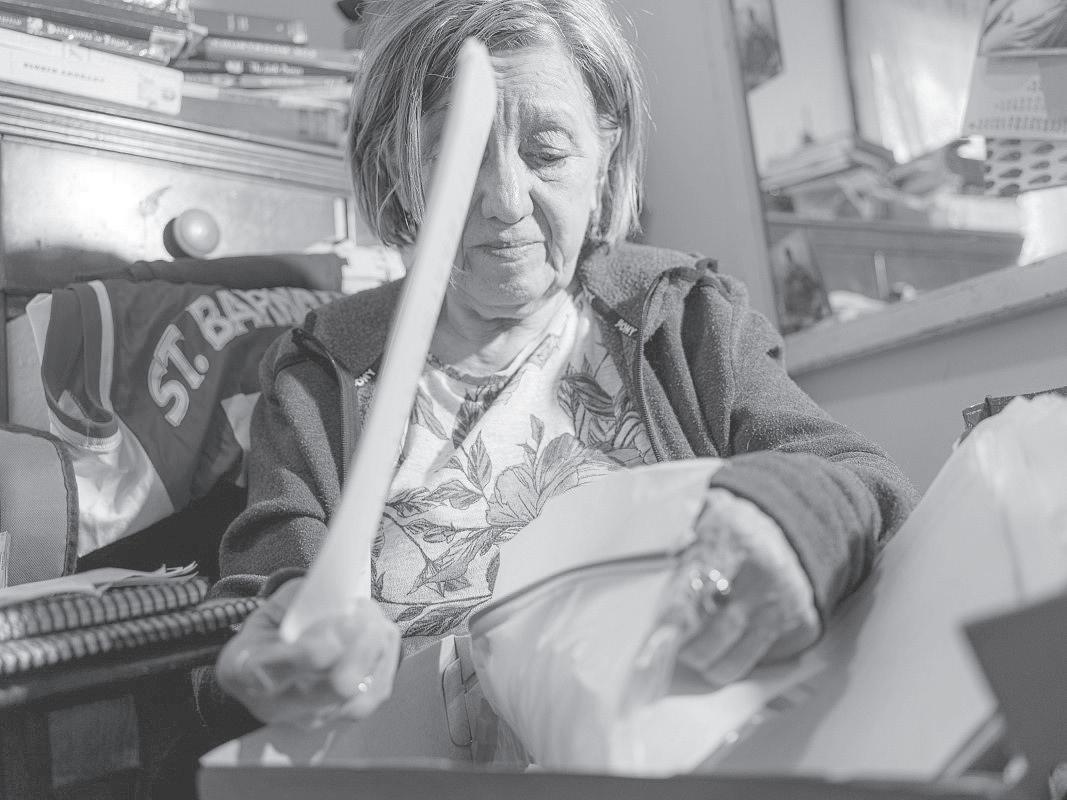
Colon have yet to face disciplinary action in those cases, records show.
Union officials for Teamsters Local 700, which represents the more than 2,000 correctional officers who work at the jail, did not return messages seeking comment.
Injustice Watch has sued the Cook County medical examiner for the release of surveillance video related to Colon’s and Reasonover’s deaths under the Illinois Freedom of Information Act. Those cases are still pending in Cook County Circuit Court.
Detainees’ families left scrambling for answers
Injustice Watch found examples of inadequate medical care and delayed responses to medical emergencies in the lead up to at least four deaths at the jail in 2023.
Only the deceased’s next of kin is able to request and access those records. Injustice Watch helped two mothers navigate the bureaucratic process to obtain their sons’ medical records.
In one of those cases, records show Makavelle Sampson, twenty-fix, had complained about severe headaches days before he died of an overdose in September. An autopsy later found Sampson had a two-inch-thick brain tumor that
emergency and falsified work-related records. He was recommended for termination, but retired before the case was completed, Dart’s spokesperson said.
Jail supervisors recommended a forty-five-day suspension for Stubenvoll and a 120-day suspension for Collier, but they haven’t served their suspensions yet, and neither have been relieved of their police powers in the meantime, Dart’s spokesperson said.
Richardson’s mother, Sharron Wesley, told Injustice Watch she was never informed about the internal investigation into her son’s death, which was closed three months ago.
“That was my baby, and they won’t tell me what the hell happened to him,” she said.
Lack of transparency with the families of the deceased is a common thread in all cases, Injustice Watch found.
went undetected in the six years he was incarcerated pre-trial at the jail. A county pathologist said the tumor was a significant contributing factor in his death.
Sampson’s mother said her son would complain about his headaches almost every time they talked on the phone. “I just kept telling him to put in requests for medical. … It hurts to know he wasn’t helped,” Nakisha Sampson said.
In the other case, records show Terron Richardson, thirty-three, had a history of refusing to take his prescribed medications before dying from a seizure in May 2023. However, on the day he died at the jail’s hospital, an officer tried to alert medical staff of his condition, but the medical staff member “simply walks away,” according to an internal investigation.
A spokesperson for Cermak Health Services, the division of Cook County Health that renders medical services in the jail, said the involved medical staff member no longer works for the county.
The jail’s medical director, Dr. Priscilla Ware, declined an interview request.
Three officers assigned to Richardson’s unit—Lt. Albert Stubenvoll and deputies Bruno F. Roti and Xavier Collier—faced disciplinary charges over his death, records show.
Investigators found Roti failed to appropriately respond to a medical
The families of six detainees who died all said they were left with basic questions about what happened to their loved ones in Dart’s custody, despite a state law requiring the sheriff to appoint one of his staff members to serve as a liaison for each family and provide them with answers.
Nina Singleton, thirty-five, was visibly unwell in the mental health unit the night before she died from an overdose—so much so she needed help from three detainees to get to her bed, records show. She was dead by medical call the next morning.
Her mother, Nicole Brown, said a member of Dart’s office told her that her daughter had died but never followed up.
“I tried to contact him afterwards trying to see what was going on … and he apologized for no one getting back to me, but that was it,” she said.
Dart’s spokesperson acknowledged the sheriff’s office should be doing more to keep families informed. “Clearly, if family members feel that they are in the dark, there is more that we can do,” he said.
Jail deaths show oversight is faltering, expert says
Families of the deceased are not the only ones missing critical information about deaths under Dart’s watch.
State law requires sheriffs to file reports about deaths in their custody

within thirty days to state regulators with basic information, including the decedent’s name, age, and “a brief description of causes, contributing factors and the circumstances surrounding the death.”
Injustice Watch obtained all of the reports submitted to the state’s Jail and Detention Standards Unit by Dart’s office since the start of his first term in December 2006. The reports have grown thinner in recent years, and failed to include required information about the circumstances behind the deaths in each of the eighteen cases from 2023.
In the section labeled “summary of specific details of occurrence” for the report about Colon’s death, for example, Dart’s office only reported his time of death, and
failed to include any of the grisly details— details known to jail officials the day Colon died.
Omitting key details about detainees’ deaths defeats the purpose of the reports, which are meant to improve oversight and inform state officials and the public about conditions in the jail, said Jennifer VollenKatz, executive director of the John Howard Association of Illinois, an independent watchdog group that monitors the state’s prisons and, in the past, also monitored Cook County Jail.
“Reports that do not contain the statutorily required information thwart this effort and undermine efforts to keep people in custody safe,” Vollen-Katz said.
Dart’s staff provided no explanation for
the inadequate reports to state officials, but said that any omissions were inadvertent and that his office is “incredibly transparent with stakeholders regarding deaths in custody.”
In a statement, a spokesperson for the Illinois Department of Corrections said members of the Jail and Detention Standards Unit are “actively reviewing” the incomplete death reports submitted by Dart’s office “and working with them to improve reporting.”
All deaths in custody also trigger an investigation with the sheriff’s own Office of Professional Review, which handles disciplinary cases against guards and other staff.
Aside from the three officers disciplined for Richardson’s death, only one other officer has received any punishment over deaths in custody last year so far, while half of the investigations remain open, even for deaths from nearly 500 days ago, records show.
Dart’s senior level staff also conducts internal reviews for each in-custody death to identify broader policy violations and issue recommendations.
In early April, when Injustice Watch requested copies of the internal probes, Dart’s staff had finished reviewing only six of the eighteen deaths from last year. His spokesperson said eight more have been completed since then.
The corrective changes stemming from the six reviews provided to Injustice Watch mostly involved reminding staff to follow basic protocols. For example, in the weeks and months after Colon died, guards were reminded via emails and at roll call
to check the whole bathroom area during their thirty-minute security checks and to call for medical attention when detainees are in distress. The reminders included no mention of Colon or the lapses that preceded his death, records show.
Most of last year’s deaths were also investigated by the state police at the request of the sheriff’s office and forwarded to county prosecutors. But the Cook County State’s Attorney’s Office has so far not filed criminal charges against anyone involved in the deaths, meaning the police investigations end up shelved and rarely see the light of day.
Ultimately, the investigations and death reviews are better at identifying individual policy violations than systemic issues that percolate from the top down, said Deitch, the correctional oversight expert at the University of Texas at Austin.
“If each and every case is looked at just on its own, then you’re never going to notice patterns,” she said.
When asked if he would welcome independent oversight of the jail, Dart’s spokesperson said his boss is already “held accountable daily by a host of government agencies, elected officials, and the citizens who elect him and other office holders.”
Yet none of those efforts have so far resulted in anyone being held accountable in Colon’s death. A year and a half later, his sister has low expectations.
“I don’t think they’ll do right by my brother.” ¬

Therapy ‘Speed Dating
The event connected Latinx community members with culturally sensitive therapists, promoting mental health awareness.
BY SOFIA MCDOWELLIn a heartening blend of culture, community, and mental health, earlier this month, Sin Titulo, a Pilsen-based apparel brand, partnered with Latinx Talk Therapists to host a remarkable event focused on connecting and finding a longterm therapist in a supportive and relaxed setting.
Finding your therapist – Speed Dating, offered attendees a unique “speed dating” format, allowing them to interact and engage with six different therapists for fifteen minutes each, rotating to the next one after each session. This innovative approach was praised by its attendees for its effectiveness in making therapy less intimidating and more accessible.
Around thirty attendees had the chance to engage directly with therapists, a crucial step in finding the right match. “Whether you’re looking to find a therapist who understands your cultural background, specializes in a specific type of therapy, or just want to explore your options, this event is for you,” the promotional material promised, and the event delivered.
Irais Elizarraraz, Sin Titulo cofounder, highlighted the significance of such events for the community, stating, “I love doing these community events, providing resources... We always get asked, how do I find the right therapist? How do I know what to ask?” These questions were at the heart of the event, providing clarity and support to those navigating their mental health journeys.
Ernestina Perez, the founder of Latinx Talk Therapy, also emphasized the broader mission of destigmatizing mental health within the community. “I really love that idea that people can bring any questions and things,” she said. “With about 80

percent of Latinx Talk Therapy clients being first-time therapy users, events like this play a crucial role in demystifying the therapeutic process and encouraging more individuals to seek help.”
Sin Titulo began its journey as an apparel brand at the beginning of the pandemic in August 2020. It was founded by the Elizarraz sisters, Irais, Diana, and Itzel.
“We started off just doing apparel, and it was definitely during the pandemic as a solution for us,” explained Elizarraraz. “I wanted to go into a grocery store and still be able to stand loud and proud of my heritage, of what I stand for, social justice, whatever it was,” she added.
The Pilsen-based apparel brand began branching out by collaborating with local brands and hosting pop-ups.
As the COVID-19 restrictions lifted, the brand evolved to include community events, emphasizing mental health discussions and resources. “The reason why
we started doing events is because I wanted more of a relationship post-shipping off a shirt,” Elizarraraz said.
Fruits of My Labor, the mental health portion of Sin Titulo’s community events, focuses on providing resources and a safe environment to prepare attendees for conversations with their therapists and to open the floor to network and meet other individuals on similar mental health journeys.
Perez, who immigrated from Mexico City and grew up in Joliet, emphasized the importance of cultural sensitivity in therapy. “I grew up around a lot of immigrants, and I just could kind of see the different struggles that we were all having,” she said, noting the lack of resources for Latinx mental health.
Sin Titulo’s unique concept has allowed for a seamless integration of topics such as mental health, social justice, and the specific needs of immigrants and children of immigrants. These buckets are carried out throughout the brand designs and the events hosted. “Mental health is dope,” as
one of the Sin Titulos t-shirts reads was the special drop that inspired this event.
“I love that you can kind of shop around and talk to people,” said Perez.
The collaboration with Latinx Talk Therapy is dedicated to providing culturally sensitive mental health services. Perez shared her vision for the organization: “I wanted to bring these therapists together to define what Latinx mental health is and really use these evidence-based training and skills that we learn, and use them with the community.” Perez’s background and passion for bridging gaps in mental health care for the Latinx community have been instrumental in shaping the organization’s mission and outreach.
Elizarraraz shared the inspiration behind integrating mental health into Sin Titulo’s events, reflecting on her personal experiences with therapy and the community’s need for accessible mental health resources. “We already do mental health discussions. Now let’s have an opportunity for us to just socialize and talk about our healing journeys,” she noted, emphasizing the importance of continuous support and dialogue.
The event was more than just a networking opportunity; it was a celebration of community resilience and a step towards collective healing. With organizations like Sin Titulo and Latinx Talk Therapy leading the way, the future looks promising for culturally sensitive mental health support within the Latinx community.
To learn about upcoming events or shop Sin Titulos designs visit Sintituloshop. com ¬
Sofia McDowell is a freelance writer, blogger and marketing professional.
Encontrando un terapeuta culturalmente apropiado
El evento fue más que una oportunidad para establecer contactos entre terapeutas y pacientes potenciales; fue un paso hacia la sanación colectiva.
POR SOFIA MCDOWELL TRADUCIDO POR JACQUELINE SERRATO
En una interesante combinación de cultura, comunidad y salud mental a principios de este mes, Sin Titulo, una marca de ropa con sede en Pilsen, se asoció con Latinx Talk Therapists para organizar un evento extraordinario enfocado en conectar y encontrar un terapeuta a largo plazo en un entorno relajado de apoyo.
Finding Your therapist – Speed Dating ofreció a los asistentes un formato único de “citas rápidas”, que les permitió interactuar y conocer a seis terapeutas diferentes durante quince minutos cada uno, rotando al siguiente después de cada sesión. Este enfoque innovador fue elogiado por los participantes por su eficacia para hacer que la terapia sea menos intimidante y más accesible.
Alrededor de treinta asistentes tuvieron la oportunidad de interactuar directamente con los terapeutas, un paso crucial para encontrar la opción adecuada. “Ya sea que esté buscando un terapeuta que comprenda su origen cultural, se especialice en un tipo específico de terapia o simplemente quiera explorar sus opciones, este evento es para usted”, prometía el material promocional, y el evento cumplió.
Irais Elizarraraz, cofundadora de Sin Titulo, destacó la importancia de este tipo de eventos para la comunidad y afirmó: “Me encanta realizar estos eventos comunitarios, brindar recursos... Siempre nos preguntan: ¿cómo encuentro al terapeuta adecuado? ¿Cómo sé qué preguntar?”. Estas preguntas determinaron el evento, ya que brindaron claridad y apoyo a quienes quieren mejorar su salud mental.
Ernestina Pérez, fundadora de Latinx Talk Therapy, también enfatizó la misión más amplia de desestigmatizar la salud mental dentro de la comunidad. “Realmente me encanta la idea de que las personas
puedan traer cualquier pregunta o cosa”, dijo. “Dado que aproximadamente el 80 por ciento de los clientes de Latinx Talk Therapy son usuarios de terapia por primera vez, eventos como este juegan un papel crucial en la desmitificación del proceso terapéutico y en alentar a más personas a buscar ayuda”.
Sin Titulo comenzó su trayectoria como marca de ropa a principios de la pandemia en agosto de 2020. Fue fundada por las hermanas Elizarraz: Irais, Diana e Itzel.
“Comenzamos simplemente haciendo ropa, y definitivamente fue durante la pandemia como una solución para nosotros”, explicó Elizarraraz. “Quería ir a la tienda y aún así poder estar orgullosa de mi herencia, de lo que represento, la justicia social, lo que fuera”, agregó.
La marca de ropa con sede en Pilsen comenzó a diversificarse colaborando con marcas locales y organizando eventos espontáneos.
A medida que se levantaron las restricciones de COVID-19, empezaron a hacer eventos comunitarios, enfatizando las discusiones y los recursos de salud mental. “La razón por la que comenzamos a hacer eventos es porque quería una mayor relación después de venderles una camiseta", dijo Elizarraraz.
Fruits of My Labor, la sección de salud mental de los eventos comunitarios de Sin Titulo, se enfoca en brindar recursos y un entorno seguro para preparar a la gente para las conversaciones con sus terapeutas y abrir el espacio para establecer contactos y conocer a otras personas con metas similares.
Pérez, quien emigró de la Ciudad de México y creció en Joliet, enfatizó la importancia de la sensibilidad cultural en la terapia. “Crecí rodeada de muchos inmigrantes y pude ver las diferentes luchas que todos estábamos teniendo”, dijo, señalando la falta de recursos para la salud
mental de los latinos.
El concepto de Sin Titulo ha permitido una integración perfecta de temas como la salud mental, la justicia social y las necesidades específicas de los inmigrantes y los hijos de inmigrantes. Estos temas se llevan a cabo en todos los diseños de la marca y los eventos organizados. “La salud mental es genial”, como dice una de las camisetas de Sin Titulos, fue la frase del lanzamiento especial que inspiró este evento.
“Me encanta poder hacer compras y hablar con la gente”, dijo Pérez.
La colaboración con Latinx Talk Therapy está dedicada a brindar servicios de salud mental culturalmente sensibles. Pérez compartió su visión para la organización: “Quería reunir a estos terapeutas para definir cómo es la salud mental entre los latinos y realmente usar esta capacitación y las habilidades basadas en evidencia que aprendemos, y usarlas con la comunidad”.
La experiencia y la pasión de Pérez por cerrar brechas en la atención de salud mental para la comunidad latina han sido fundamentales para dar forma a la misión y el alcance de la organización.
Elizarraraz compartió la inspiración
On Saturday, October 15, 2022, around 4:15 P.M. this couple was driving westbound on Archer Avenue. There was a driver going eastbound at a reckless speed, well above the speed limit, in a Jeep Cherokee that T-boned this couple’s Nissan Murano at the intersection of Poplar Street & Archer Avenue. The wife was in the passenger seat and died instantly at impact. The husband died in the ambulance en route to the hospital. It took the fire department over 45 minutes to pull the wife’s body out of their vehicle They were married 65 years. Their family and friends are seeking justice through the court system with the help of a witness or video
detrás de la integración de la salud mental en los eventos de Sin Titulo, reflexionando sobre sus experiencias personales con la terapia y la necesidad de la comunidad de recursos de salud mental accesibles. “Ya hacemos pláticas sobre salud mental. Ahora tengamos una oportunidad para socializar y hablar sobre nuestras trayectorias de sanación”, señaló, enfatizando la importancia del apoyo y el diálogo continuos. El evento fue más que una oportunidad para establecer contactos; fue una celebración de la resiliencia comunitaria y un paso hacia la sanación colectiva. Con organizaciones como Sin Titulo y Latinx Talk Therapy liderando el camino, el futuro parece prometedor en cuanto al apoyo de salud mental culturalmente apropiado dentro de la comunidad latina. Para conocer los próximos eventos o comprar prendas de Sin Titulos, visite sintituloshop.com ¬
Sofia McDowell es escritora independiente, bloguera y profesional de mercadotecnia. Su última nota fue sobre los jóvenes, inmigrantes y presos que votaron en las elecciones.

If you witnessed the crash on
If you know of anyone who witnessed the crash, please
Our thoughts in exchange for yours.
The Exchange is the Weekly’s poetry corner, where a poem or piece of writing is presented with a prompt. Readers are welcome to respond to the prompt with original poems, and pieces may be featured in the next issue of the Weekly
So You’re Dating a Girl From Chicago by
chima “naira” ikorothere go your lil girlfriend - an attempt to discover if you are single.
bro - a form of endearment.
g - the highest form of endearment.
you irritatin’ - i am falling for you.
i’m not finna play witchu bro - i possess a vast amount of socio-emotional intelligence and can see past your facade.
naw, his ass be tweakin’. (said to an inquiring friend) - i’m unsure of where we stand due to his lack of communication or general behavior, thus i am losing hope.
put that on some - i need an oath to ensure i can trust you.
you good?? - do i need to reconsider this romantic exchange?
i’m coolin’. - i’m taking a step back from this romantic exchange, or i am lowering my expectations.
you good. - i am nullifying this romantic exchange.
naw i’m good. (preceded by laughter) - i’ve already started talking to your friend.

Chima Ikoro is the Weekly’s Community Builder.
THIS WEEK'S PROMPT: “WRITE A ‘TRANSLATION’/GLOSSARY FOR EMOTIONS YOU OFTEN FEEL BUT CANNOT EXPLAIN.”
This could be a poem, journal entry, or a stream-of-consciousness piece. Submissions could be new or formerly written pieces. Submissions can be sent to bit.ly/ssw-exchange or via email to chima.ikoro@southsideweekly.com
Our thoughts in exchange for yours.
The Exchange is the Weekly’s poetry corner, where a poem or piece of writing is presented with a prompt. Readers are welcome to respond to the prompt with original poems, and pieces may be featured in the next issue of the Weekly
FEATURED BELOW IS A RESPONSE TO A PREVIOUS PROMPT FROM A READER. THE LAST POEM AND PROMPT CAN BE FOUND ONLINE.
See by isi frank ativieSee the Black man living in this American society which is so-called “The greatest country in the world.”
See the Black man running away from this society that is butchering his soul, heart, confidence, and spirit with a razorsharp blade.
See the Black man searching for strong love. He is searching for it while wandering around so high in the sky like a dove.
See the Black man running from the life of hell. An unpleasant experience he knows too well.
See the Black man searching for a life that is nothing but fair. A life that is nice and cool like a breath of fresh air.
See the Black man recovering from a long period of pain. A tedious feeling that has been driving him insane.
See the Black man seeking chances of hope to live a brighter day, although that same hope tends to eventually fade away.
See the Black man who devotes his time to protecting anything that he coins “It’s mine.”
See the Black man pushed into the cold of perpetual racism that is everlastingly old.
See the Black man constantly pray that his rights and dignity will never be taken away, even by his oppressors who attack

him every single day.
See the Black man who can’t help but cry, knowing he will be stuck in a state of misery and die.
See the Black man suffocate through a deadly chokehold of constant hate.
See the Black man lends his heart to someone who continues to tear it apart.
See the Black man who’s trying to fly high to reach for freedom which is far into the blue sky.
See the Black man who is looking for peace, while his oppressors look at him as a menacing beast.
See the Black man who wants to remain strong but is still unsure if he can keep this spirit for so long.
See the Black man who makes sacrifices in his life, but is hit with a list of disappointments that cut deeply with a knife.
There are some people who see how the Black man survives in this society and there are others who don’t. There are people who want to know his struggles, and there are some who won’t.
I wonder how fair and equal this society would be, if people could take the time to wake up and just simply “see.”




